Searched: \.*
Results from Spoofax web
We keep track of all resolved issues at our YellowGrass issue tracker. Below is an overview of released versions. We also maintain a roadmap of past and future versions.
Support for using Spoofax languages outside of Eclipse is provided by Spoofax Sunshine. Usage instructions are available at https://github.com/metaborg/doc/blob/master/spoofax/sunshine/sunshine.md.
The Spoofax project consists of the following components:
| Spoofax/IMP | |
| IMP | |
| Stratego | |
| Stratego/J | |
| STRJ | |
| SDF | |
| JSGLR | |
| Aster |
Using Maven Tycho
Spoofax project can be built continuously using a combination of Maven, Tycho and Ant. Using Maven should make it easy to run it in a continuous build server like Hudson. We use the same techniques described here in our continuous builds on Hydra. Make sure you have the following software installed:- Maven 3.0
- Ant
- Eclipse with Spoofax installed
- https://svn.strategoxt.org/repos/StrategoXT/hydra/spoofax-fun.nix
- https://svn.strategoxt.org/repos/StrategoXT/hydra/eclipse.nix
Installing Spoofax from command-line
You can install Eclipse and Spoofax like described here. However, in a continuous build/integration setting it is sometimes useful to be able to perform these actions from the command-line. Note that this script uses the Spoofax unstable update site.cd $ECLIPSE # remove vm args sed -i 's|-Xms[0-9]*m||' eclipse.ini sed -i 's|-Xss[0-9]*m||' eclipse.ini sed -i 's|-Xmx[0-9]*m||' eclipse.ini sed -i 's|-XX:MaxPermSize=[0-9]*m||' eclipse.ini sed -i '/^$/d' eclipse.ini perl -pi -e "s/^\r\n//" eclipse.ini # add own default vmwargs echo "-Xms256m" >> eclipse.ini echo "-Xss8m" >> eclipse.ini echo "-Xmx1024m" >> eclipse.ini echo "-XX:MaxPermSize=256m" >> eclipse.ini echo "-server" >> eclipse.ini # install spoofax ALL_SITES="http://spoofax.org/update/unstable" java -Xmx512m -jar plugins/org.eclipse.equinox.launcher_*.jar -application org.eclipse.equinox.p2.director -metadataRepository $ALL_SITES -artifactRepository $ALL_SITES -installIU org.strategoxt.imp.feature.group -data ../data -consolelog
Setting up Maven
Create a directory with the editor plugin project, feature project and update site project in it. Then issue the following command (replace version and groupId with something appropriate) to generate the maven pom.xml files:mvn org.sonatype.tycho:maven-tycho-plugin:generate-poms -Dversion=1.0-SNAPSHOT -DgroupId=mygroup -Dtycho.targetPlatform=$ECLIPSEIf you want to run tests, like JUnit tests, make sure you add org.junit4 to your plugin dependencies and MANIFEST.MF. If your tests reside in your main plugin, you will need to edit the generated pom.xml file of that plugin. Replace,
<packaging>eclipse-plugin</packaging>by,
<packaging>eclipse-test-plugin</packaging>If you have your tests in a seperate plugin which name ends with tests, Tycho should recognize this and change the packaging element for you.
Running ant builds
Before running Maven you need to use build.main.xml of the Spoofax project(s) to generate some code/files that spoofax normally generates automatically from Eclipse (parsetables, java code from stratego, etc.)export LOCALCLASSPATH="utils/aster.jar:utils/make_permissive.jar:utils/sdf2imp.jar:utils/strategoxt.jar" export ANT_OPTS="-Xss8m -Xmx2048m" export PATH=$PATH:$ECLIPSE/plugins/org.strategoxt.imp.nativebundle_*/native/linux/ for d in */build.main.xml ; do cd `dirname $d` mkdir -p utils cp -Rv `find $ECLIPSE -name strategoxt.jar` utils/ cp -Rv `find $ECLIPSE -name aster.jar` utils/ cp -Rv `find $ECLIPSE -name sdf2imp.jar` utils/ cp -Rv `find $ECLIPSE -name make_permissive.jar` utils/ ant -f build.main.xml -Declipse.spoofaximp.jars=utils all cd .. done
Running Maven build
When this is done, the project can be built using:mvn package -Dtycho.targetPlatform=$ECLIPSE -eIf this is done successfully, you should have an update site available in your update site project directory. If you would like to run the testsuites perform:
mvn integration-test -Dtycho.targetPlatform=$ECLIPSE -e
Debugging Stratego in Spoofax Projects
Spoofax supports debugging of Stratego code used in the implementation of the various editor services. The Stratego debugger re-uses the Eclipse Debug Perspective making debugging Stratego code similair to debugging Java code. Debugging can be enabled/disabled per project as it has a negative impact on the performance. The debugger has to be enabled for two components: (1) enable debug instrumentation in the ant build file and (2) enable the debug mode for the runtime. Currently, debugging support is only available in the nightly builds of Spoofax, use http://spoofax.org/update/nightly as the Eclipse Update site.Enable Debug Instrumentation
First, to enable debug instrumentation add a file called .debugmode in the project directory. Adding this file will make sure the project is build with debug information. Second, change the provider in the Builders.esv file from ctree to jar. And third, change the "all" ant target from<target name="all" depends="spoofaximp.default"/>to
<target name="all" depends="spoofaximp.default.jar"/>Now rebuild the project. After a succesful build the trans-debug directory contains the stratego files from the trans directory instrumented with debug information. The instrumented stratego files are compiled to a jar file that is located in the include directory.
Enable Debug Runtime
Although the project is build with debug information the debug mode still has to be enabled. It is wise to only enable debug mode when it is really needed as it has a huge impact on the performance. Disabling debug mode will still instrument the stratego code, but any breakpoints are ignored. Select a DSL file (probably in the test directory of the project). Select Enable debug mode from the Transform menu to enable stratego debugging for this Spoofax project.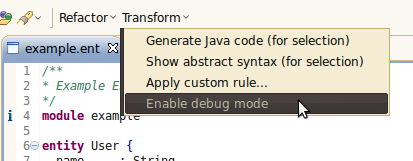 Sometimes the project will rebuild.
Check if the debug mode was actually enabled by clicking on the Transform menu, the Enable debug mode menu item should have changed to Disable debug mode.
If not select the Enable debug mode menu item again.
Now open a stratego file and set a breakpoint.
Sometimes the project will rebuild.
Check if the debug mode was actually enabled by clicking on the Transform menu, the Enable debug mode menu item should have changed to Disable debug mode.
If not select the Enable debug mode menu item again.
Now open a stratego file and set a breakpoint.
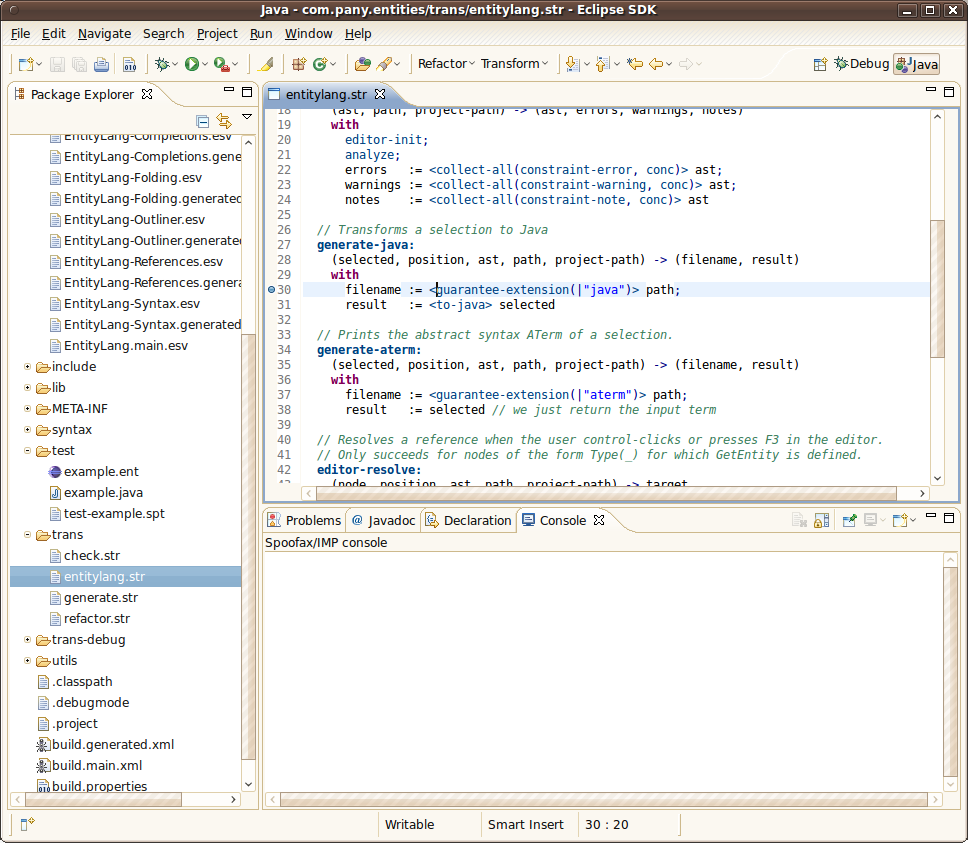 When this breakpoint is hit Eclipse switches to the Debug View and the execution is suspended.
When this breakpoint is hit Eclipse switches to the Debug View and the execution is suspended.
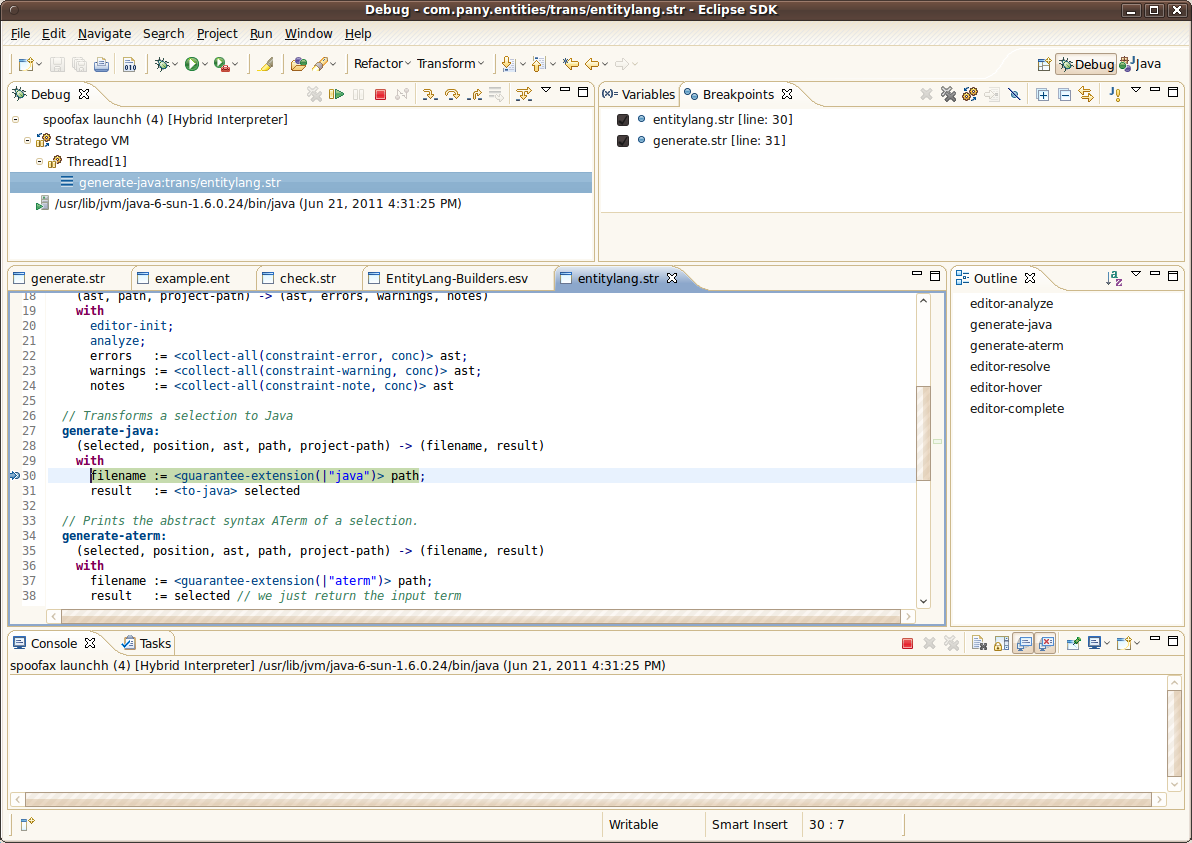 The variables window shows the available variables, the current term (*current*) and the names of the dynamic rules that are available (*dynamic rules*).
The variables window shows the available variables, the current term (*current*) and the names of the dynamic rules that are available (*dynamic rules*).
 Also, you can control the execution of the program with Step Into (F5), Step Over (F6), Step Return (F7) and Resume (F8).
Also, you can control the execution of the program with Step Into (F5), Step Over (F6), Step Return (F7) and Resume (F8).
 -- RickyLindeman - 22 Jun 2011
-- RickyLindeman - 22 Jun 2011Spoofax Contributors
- Eelco Visser (project lead)
- Lennart Kats (lead developer)
- Karl Trygve Kalleberg (lead developer of the Stratego/J runtime and JSGLR)
- Gabriel Konat
- Maartje de Jonge
- Nathan Bruning
- Ricky Lindeman
- Rob Vermaas
- Tobi Vollebregt
- Vlad Vergu
Source code
The sources of the Spoofax/IMP are available from Subversion.Continuous build
Eclipse update site with the latest result from SVN trunk. You don't want this. Just for testing.License
Spoofax/IMP is licensed under the GNU Lesser General Public License (LGPL).Collaboration
The Spoofax developers usually hang out at the #spoofax IRC channel on FreeNode (web version). Feel free to drop by!Spoofax: ontwikkeling van domein-specifieke talen in Eclipse
Zie ook de sessiebeschrijving op de devnology website.Installatie
Installeer voor deze sessie een van de volgende Eclipse installaties met Spoofax voorgeinstalleerd: Eclipse 3.6 + Spoofax voor Linux Eclipse 3.6 + Spoofax voor Linux 64-bits Eclipse 3.6 + Spoofax voor Mac 64-bits (oudere Macs: Eclipse 3.6 + Spoofax) Eclipse 3.6 + Spoofax voor Windows (Windows 64-bits: Eclipse 3.6 + Spoofax)Tutorial materiaal
Handout? (pdf) Eclipse projects? (volg de handout en importeer het initiele project Calculang0 in de Eclipse workspace)Supporting material and documentation:
- A Tour of Spoofax/IMP (recommended)
- Editor service descriptors are documented in generated Spoofax files (e.g., YourLang-Colorer.generated.esv)
- Scientific publications and presentations, including the paper The Spoofax Language Workbench, describing the architecture of Spoofax and the development of a new language and IDE
- The Stratego API reference
- Continuous building Spoofax plugins using Maven Tycho
- Debugging Stratego code in Spoofax Projects
- Spoofax in 14 Days (assignments from compiler construction course)
Example
eclipse.ini file, taken from an OS X system:
-startup ../../../plugins/org.eclipse.equinox.launcher_1.1.0.v20100507.jar --launcher.library ../../../plugins/org.eclipse.equinox.launcher.cocoa.macosx.x86_64_1.1.0.v20100503 -showsplash org.eclipse.platform --launcher.XXMaxPermSize 256m --launcher.defaultAction openFile -vmargs -Xss8m -Xms256m -Xmx1024m -XX:MaxPermSize=256m -server -Xdock:icon=../Resources/Eclipse.icns -XstartOnFirstThread -Dorg.eclipse.swt.internal.carbon.smallFonts -Djava.net.preferIPv4Stack=trueNote that every option appears on a separate line, with no following spaces, and that the memory options appear after the
-vmargs option. The -Xmx and -Xms options replace corresponding options that may have been in the existing file. Setting these options ensures that Eclipse has sufficient memory to dynamically load editors and is prepared for a full meta-programming environment.
(back to download page)EntityLang (tour with screenshots)
The EntityLang language shows some of the Spoofax basics, and comes with a short tutorial and screenshots. A basic version of language is included in the "new project" wizard. TourCalculang
A simple calculator language, illustrating basic syntax and transformations. https://svn.strategoxt.org/repos/StrategoXT/spoofax-contrib/calculang/NWL
Based on the WebDSL language, NWL is a pedagogical language definition. NWL source codeMobl
Mobl is a language for programming mobile phones.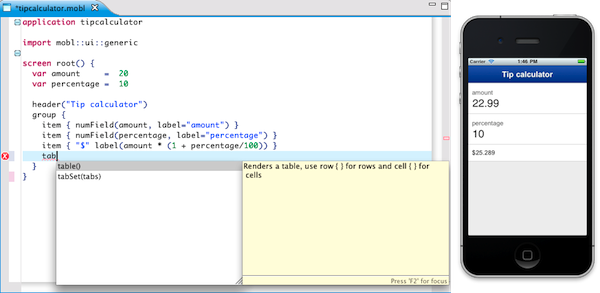 http://mobl-lang.org
https://github.com/mobl/mobl
http://mobl-lang.org
https://github.com/mobl/mobl
Lua
Lua is a dynamically typed, lightweight, embeddable scripting language. Spoofax-Lua is an Eclipse plugin for Lua built using Spoofax, featuring reference resolving, type analysis and content assist. https://github.com/tvo/spoofax-lua#readmeUpdates of Spoofax cause Eclipse to time out; why?
Due to a known problem with the combination of Eclipse 3.7, Java 1.7, and Windows, the update manager can be very slow or time out when downloading plugins. As a workaround, you can add the option-Djava.net.preferIPv4Stack=true to your eclipse.ini file, as described on the Download page.
Sometimes Spoofax says "see error log." Where can I find it?
Go to Window > Show view > Error log.Which files of a language project should I check into my SVN/CVS/GIT/etc. version management system?
You should check in all files, except for the bin and include distribution directories. Some Spoofax projects also have a utils directory that does not have to be checked in. Be sure to check in the hidden files/directories that Eclipse maintains (.project, .classpath, and .externalToolBuilders). If you use an Eclipse plugin such as Subclipse, it'll check these files in automatically. If you want, you can skip some of the .generated files, but at this point the build.generated.xml and lib/editor-common.generated.str files are required to build the project.How can I compile my Stratego specification to a JAR file instead of an interpreted ctree?
In your build.main.xml file, change this line:<target name="all" depends="spoofaximp.default.ctree"/>into
<target name="all" depends="spoofaximp.default.jar"/>Then in your editor/YourLanguage-Builders.esv, change the provider from provider: include/yourlang.ctree to provider: include/yourlang.jar. (There may already be a provider: include/yourlang-java.jar entry there.) When you distribute your plugin, be sure you set the "unpack" option to "true" for your plugin.
How do I deploy my language plugin to other users?
Either distribute it in source form to other Spoofax users, or follow the steps of our Tour to distribute it as an Eclipse plugin that does not require an existing installation of Spoofax.How can I use Spoofax with C-based Stratego projects?
Stratego projects written with the C version of Stratego typically have a very different project structure from the one employed by Spoofax projects. To migrate these projects to Spoofax, we advise users to create a new Spoofax project with a wizard and adapt the existing project to this structure. The `build.main.xml` file can be used to set any Stratego options and file locations for use with the Ant build system. Also see the next question.How can I suppress errors in the Stratego editor in legacy Stratego projects?
Add a file called `.disable-global-analysis` to disable all non-local errors. Any local errors such as missing local variables will still be reported, but non-local errors such as missing strategies or constructors will then be ignored. Use `.warn-global-analysis` to print warnings instead for non-local errors.If I have two versions of the same language in my workspace, which one will be used?
If you have two versions of a language (e.g., one version installed as a plugin and another loaded from source), the last version that you loaded "wins." Any Java components loaded using the default Eclipse plugin system can only be loaded from installed.How can I call Java methods from my editor?
See The Tour: Adding Java components.When does Eclipse show the Spoofax console?
The Spoofax console can be used to print debugging messages. It is only shown for editors that have been dynamically loaded from source; not for editors that are deployed to end users.How do I debug my Stratego code?
Stratego does not have a stepping debugger at this point. Instead, you can try <debug(!"some message)> x to print a message in the console with the value of term x, or just debug(!"some message") to print the message and the current term. You can also use the with keyword in rewrite rules as follows:rewrite: x -> x' with x' := <s> ....which ensures that a stack trace is printed when the body of the with fails (e.g., because s cannot be applied).
How can I output multiple files from a Stratego rule?
You can write directly to a file as follows:
handle := <fopen> ("somefilename.ext", "w");
<fputs> ("file contents string", handle);
fclose
If you use this API from a builder or on save rule, you can change it to the following form to ensure it only writes files statements like the above:
generate-java: (selected, position, ast, path, project-path) -> None()
How can I use concrete syntax with Spoofax?
See YellowGrass issue 55.When I hit "build project" nothing seems to happen? What's wrong?
Eclipse must have decided that you already ran the Ant file that controls the build. Just edit and save one of the files in the project and try again.Eclipse gets very slow after using it for some time or when opening many editors
The most common cause of this is a lack of heap memory. The default Eclipse setting of 256M (or 512M for 64-bit systems) is very small, even for casual Eclipse users. Please configure your Eclipse installation to use more memory.How can I refresh a file when Eclipse won't respond to F5?
This seems to be a common issue in Eclipse. Instead of pressing F5, right-click on the file in the package explorer and select "Refresh".When implementing content proposals, what to do when I get a NOCONTEXT term?
TheNOCONTEXT term indicates that the parser is unable to construct a valid abstract syntax tree that corresponds to the grammar, for the part of the tree where content completion is triggered. You can add additional rules to the grammar to help it make a (partial) tree for these cases, as documented on the mailing list. This is an area for future improvement. Don't hesitate to ask further questions about this topic!
Where can I find the latest bleeding edge versions of Spoofax?
The very latest builds of Spoofax can be downloaded by configuring Eclipse to use thehttp://download.spoofax.org/update/nightly update site. These versions are frequently updated, haven't undergone extensive testing, and may break existing features. If you run into any problems with the nightly releases, make sure you run the latest version and report the bug with the version number used in the issue tracker. Current resolved and unresolved issues for the nightly builds are listed in the roadmap.
"Artifact not found" during installation?
Eclipse can report this error when it tries to download an older version of Spoofax that is no longer available. (This can especially occur with the nightly builds.) Restarting Eclipse or going to the "available update sites" dialog and refreshing or deleting and re-adding the update site should solve this problem.How do I report a deadlock?
See how to report a deadlock in the Eclipse wiki.How do I call Java functions from Stratego?
You have to wrap them as Stratego strategies. If you generate a new project, the editor/java/YOURLANGUAGE/strategies/java_strategy_0_0.java class gives an example. If you want to add strategies to an existing Spoofax project, you can add further strategy classes to the same directory:- Create a new class that extends `Strategy`, following the template of `java_strategy_0_0.java`
- Add a reference to that class in InteropRegisterer.java
Where can I find answers to some of my other questions?
Maybe our documentation can answer your question. Otherwise, the YellowGrass issue tracker lists issue reports and questions from other users. You can add your own question there, or contact us directly.| Edit and use your language in one Eclipse window |

|
| Deploy your editor as a portable Eclipse plugin |

|
| Specify custom errors, warnings, and notes |

|
| Support content completion |

|
| Support reference resolving |

|
| Use concise rewrite rules for code generation |
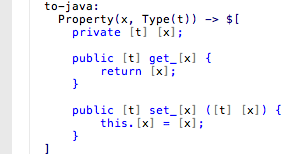
|
| Generate code directly from any editor or selection |
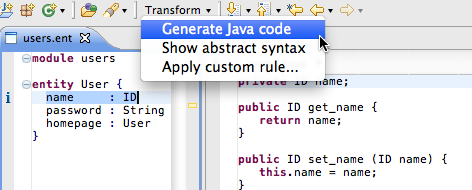
|
| Apply refactoring transformations on the source code |

|
| Get a live abstract syntax view |
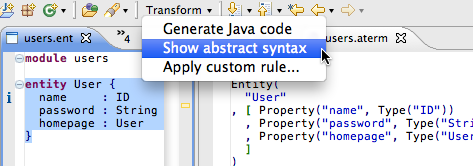
|
| Other features, including: |
- Runs on Windows, Linux, and Mac OS X
- Bracket highlighting, comment insertion
- Automatic bracket insertion and automatic indentation
- Fully automatic syntax error recovery
- Creates a basic, customizable editor using just the grammar
- Using SDF and SGLR, all context-free languages are supported. This means that language definitions can be composed and reused.
- Based on the Eclipse IMP framework, allowing interoperability with pure-Java editor components
See Spoofax web home instead.
This page reports on the Interactive Disambiguation project.
We currently implemented a stand-alone grammar generator and disambiguation suggestions tool, available from
https://svn.strategoxt.org/repos/StrategoXT/experimental/meta-amb-suggestions.
Both will be integrated into a near-future version of the Spoofax language workbench. Spoofax already supports concrete object syntax in meta programs, but still requires manual disambiguation of ambiguous quotations and anti-quotations. With this project we aim to address this issue, making meta programming with concrete syntax easier and more fun.

Submission
The submission to LWC 2011 is available as a PDF file: LWCTask-1.0-Spoofax.pdf?. The sources of the project are available via subversion at https://svn.strategoxt.org/repos/StrategoXT/spoofax-contrib/Lawoco and https://svn.strategoxt.org/repos/StrategoXT/spoofax-contrib/DatabaseLang. These projects require Spoofax 0.6.1 or higher, which is currently available from the "unstable" update site athttp://lclnet.nl/update/unstable
The screenshot below illustrates the basic syntax definition (left) of the language, an example program (upper right), and its abstract syntax (lower right).

Spoofax 1.1 released
We are happy to announce the release of Spoofax 1.1! This is the first major release since version 1.0.2 and includes major features and improvements. Spoofax 1.1 supports all current Eclipse versions, up to version 4.2.2. You can update your Eclipse from http://download.spoofax.org/update/stable One of the most important improvements in Spoofax 1.1 is the inclusion of NaBL, the Spoofax Name Binding Language. NaBL is used in all new projects created and significantly simplifies name binding analysis, as well as any editor services that depend on it (e.g., code completion, reference resolving) NaBL is documented at the following pages:- Tutorial http://metaborg.org/wiki/nabl
- Examples http://metaborg.org/wiki/nabl/examples
- Research paper http://researchr.org/publication/KonatKWV13
- Improved build process: generated files can be deleted, building & loading are separated, projects can be cleaned (http://yellowgrass.org/issue/Spoofax/577, http://yellowgrass.org/issue/Spoofax/591, http://yellowgrass.org/issue/Spoofax/578)
- Improved Stratego editor with multi-file reference resolving based on NaBL (http://yellowgrass.org/issue/Spoofax/12)
- Extended support for customizing refactoring UI (http://yellowgrass.org/issue/Spoofax/440)
- Automatic configuration of git/svn ignore settings (http://yellowgrass.org/issue/Spoofax/573)
- Added support loading for Java-based plugin dependencies, in case your plugin depends on some other plugin such as EMF (http://yellowgrass.org/issue/Spoofax/322)
- Much improved completion engine (http://yellowgrass.org/issue/Spoofax/360)
- We now show a nice warning if Eclipse is not configured with a proper stack and heap size (http://yellowgrass.org/issue/Spoofax/86)
- Files are now queued for re-analysis even if their editor is not open (http://yellowgrass.org/issue/Spoofax/224)
Spoofax Q&A
We have started a Q&A site for Spoofax to build a knowledge base of common questions and answers. Join us at http://yellowgrass.org/questions/Spoofax 2012-02-15Spoofax 1.0.2 maintenance release
Today we're releasing a minor maintenance release of Spoofax, version 1.0.2. This release fixes a memory leak that was introduced in the 1.0 release. There are no new features in this release, those will be included in the upcoming 1.1 release instead. The new version is now available from the update site athttp://spoofax.org/update/stable.
2011-12-28
Spoofax 1.0
We're pleased to announce the release of Spoofax 1.0. A number of significant new features have been added since the last stable release, a long list of bugs has been fixed, and various minor improvements were introduced. Highlights of the release include:- Support for writing tests for language definitions
- Support for defining refactorings
- Major improvements to content completion: Spoofax/289, Spoofax/357
- Support for using rewrite rules to disambiguate syntax: Spoofax/328
http://spoofax.org/update/stable.
In addition to these features, we're actively working on improving Spoofax with new features. In particular, we are now working on providing full support for debugging, on an interactive shell for Stratego and custom languages, and a new meta-language called SpoofaxLang to define languages in a more modular fashion.
A full list of feature requests and issues addressed in the new version is provided at http://yellowgrass.org/tag/Spoofax/1.0.
Refactorings
Spoofax helps you to enrich your editor with refactorings. You can find the refactorings in the context menu of the file being edited.
Refactoring Specifications
The EntityLang-Builders.esv file in the editor directory defines the entries in the Refactor menu: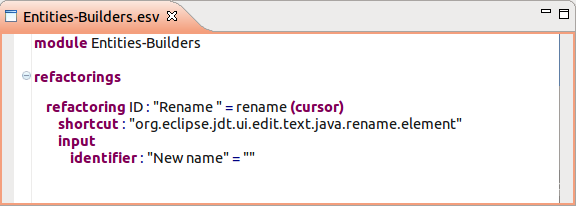 The given refactoring specifies the "Rename" menu item, which is enabled in case an ID node is selected.The menu action is bind to the rename shortcut (Shift+Alt+R). After the user applies the rename refactoring, a dialog is prompted with an input field labeled "New name" that has the empty string as initial value.
The given refactoring specifies the "Rename" menu item, which is enabled in case an ID node is selected.The menu action is bind to the rename shortcut (Shift+Alt+R). After the user applies the rename refactoring, a dialog is prompted with an input field labeled "New name" that has the empty string as initial value.
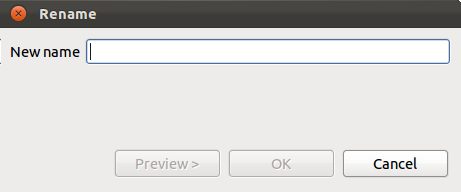 The OK button of the dialog triggers the action defined with the rename rule that we discuss in the next paragraph.
The OK button of the dialog triggers the action defined with the rename rule that we discuss in the next paragraph.
Refactoring Transformations
Refactorings are defined in Stratego. The refactor.str file in the trans directory defines the renaming refactoring for the entity language. This rule follows a fixed interface for interoperability with the editor. The left-hand-side of the rule is a tuple of: the result of the user input dialog, the selected node, its tree position, the complete ast of the file, the file path and the project path. The right-hand-side is a tuple containing the refactoring output: a list of node changes, plus lists with errors and warnings that will be reported to the user. Errors and warnings are specified as a tuple of the offending language element (which location will be reported) and the error message itself.
This rule follows a fixed interface for interoperability with the editor. The left-hand-side of the rule is a tuple of: the result of the user input dialog, the selected node, its tree position, the complete ast of the file, the file path and the project path. The right-hand-side is a tuple containing the refactoring output: a list of node changes, plus lists with errors and warnings that will be reported to the user. Errors and warnings are specified as a tuple of the offending language element (which location will be reported) and the error message itself.

| Tip: multiple-file refactorings can be specified in the change list using the root nodes: [(ast-1-before, ast-1-after), (ast-2-before, ast-2-after), ...] |
Publications
See also the publication list on researchrThe Spoofax Language Workbench
- Lennart C. L. Kats, Rob Vermaas, Eelco Visser. Integrated Language Definition Testing. Enabling Test-Driven Language Development. In Proceedings of the 26th Annual ACM SIGPLAN Conference on Object-Oriented Programming, Systems, Languages, and Applications (OOPSLA 2011), ACM, 2011. (abstract) (pdf) (bib)
- Ricky T. Lindeman, Lennart C. L. Kats, Eelco Visser. Declaratively Defining Domain-Specific Language Debuggers In Ewen Denney, Ulrik Pagh Schultz, editors, Proceedings of the Generative Programming and Component Engineering, 7th International Conference (GPCE 2011), ACM, 2011. (abstract) (pdf) (bib)
- Lennart C. L. Kats, Eelco Visser. The Spoofax Language Workbench. Rules for Declarative Specification of Languages and IDEs. In Martin Rinard, editor, Proceedings of the 25th Annual ACM SIGPLAN Conference on Object-Oriented Programming, Systems, Languages, and Applications (OOPSLA 2010), ACM, 2010. (abstract) (pdf) (bib)
- Lennart C. L. Kats, Karl T. Kalleberg, Eelco Visser. Interactive Disambiguation of Meta Programs with Concrete Object Syntax. In International Conference on Software Language Engineering (SLE 2010), Lecture Notes in Computer Science, Springer, 2010. (abstract) (draft) (bib)
- Lennart C. L. Kats, Karl T. Kalleberg, Eelco Visser. Domain-Specific Languages for Composable Editor Plugins. In Proceedings of the Ninth Workshop on Language Descriptions, Tools, and Applications (LDTA'09), Electronic Notes in Theoretical Computer Science. York, United Kingdom, March 2009. (abstract) (pdf) (bib)
- Lennart C. L. Kats, Karl T. Kalleberg, Eelco Visser. Generating Editors for Embedded Languages. Integrating SGLR into IMP. (Tool demonstration.) In Proceedings of the Eighth Workshop on Language Descriptions, Tools, and Applications (LDTA'08), April 2008. (abstract) (pdf) (bib)
Spoofax components
- Maartje de Jonge, Eelco Visser. An Algorithm for Layout Preservation in Refactoring Transformations. In Proceedings of Software Language Engineering (SLE 2011), Lecture Notes in Computer Science, Springer, 2011. (To appear.) (pdf)
- Lennart C. L. Kats, Eelco Visser, Guido Wachsmuth. Pure and Declarative Syntax Definition: Paradise Lost and Regained. In Proceedings of Onward! 2010. ACM, 2010. (abstract) (pdf) (bib)
- Lennart C. L. Kats, Eelco Visser. Encapsulating Software Platform Logic by Aspect-Oriented Programming: A Case Study in Using Aspects for Language Portability. In IEEE International Working Conference on Source Code Analysis and Manipulation 2010 (SCAM 2010), IEEE, 2010. (abstract) (pdf) (bib)
- Maartje de Jonge, Emma Nilsson-Nyman, Lennart C. L. Kats, Eelco Visser. Natural and Flexible Error Recovery for Generated Parsers. In Mark van den Brand, Jeff Gray, editors, Proceedings of Software Language Engineering (SLE 2009), pages 204-223, Lecture Notes in Computer Science, Springer, 2009. (abstract) (pdf) (bib)
- Lennart C. L. Kats, Maartje de Jonge, Emma Nilsson-Nyman, Eelco Visser. Providing Rapid Feedback in Generated Modular Language Environments. Adding Error Recovery to Scannerless Generalized-LR Parsing. In Gary T. Leavens, editor, Proceedings of the 24th ACM SIGPLAN Conference on Object-Oriented Programming, Systems, Languages, and Applications (OOPSLA 2009), pages 445-464, ACM, 2009. (abstract) (pdf) (bib)
- Karl T. Kalleberg and Eelco Visser. Fusing a Transformation Language with an Open Compiler, February 25 2007. Language Descriptions, Tools and Applications (LDTA 2007). (pdf) (bib).
The original Spoofax editor
(the following paper relates to the original Spoofax SDF and Stratego editor, not the Spoofax/IMP language workbench)- Karl T. Kalleberg and Eelco Visser. Spoofax: An Interactive Development Environment for Program Transformation with Stratego/XT. In T. Sloane and A. Johnstone, editors, Seventh Workshop on Language Descriptions, Tools, and Applications (LDTA 2007), ENTCS, pages 47--50, Braga, Portugal, March 2007. Elsevier.
Presentations
Introduction
The semantic index is a set of stratego libraries, java primitives and editor extensions that provide a language-parametric framework for doing name binding, scoping, incremental analysis and incremental compilation.Quick start
To be able to use the index a nightly version of Spoofax is required which can be retrieved from the following update site:http://spoofax.org/update/nightlyThe simplest place to get an example on what the index can do and how a project using the index looks like is generating a new Spoofax project. Go to File->New->Project, choose "Spoofax editor project" and fill in Entity as the language name. This will generate and build a Spoofax example project for you that uses the index. To test it out open up test/example.ent and try some things like resolving a reference, code completion and introducing errors by changing types to types that do not exist. These features are all provided by the index using naming annotations in the SDF file and Stratego code to fill in some gaps in the generic algorithm. The tutorial will go into more detail on how to define these things yourself. More complex examples using the index are also available. We've prototyped a mini C# subset, a C subset without macros and the entity language with functions and aspects using the index. To get these examples download this archive?, extract it somewhere, import the projects into an Eclipse workspace and build all projects (ctr+b).
Tutorial
In this tutorial we will explain how the example entity language uses the index and how to extend it with functions and simple expressions.Analysis
Name annotations
If you look at the entity language SDF definition below you will see that it has naming annotations on certain terminals (Type@=, Type@, etc) and scope annotations on productions (scope(Type)).
"module" Module@=ID Definition* -> Start {"Module", scope(Type)}
"entity" Type@=ID "{" Property* "}" -> Definition {"Entity", scope(Property)}
Property@=ID ":" Type -> Property {"Property"}
Type@ID -> Type {"Type"}
Adjust rules
Error checking
Incremental analysis
Compilation
Inner workings
Extension points
FAQ
Where can I find API documentation?
How to fix build error x?
| Web | TWiki Site Map | Use to... |
|---|---|---|
| Main |
The Main web is dedicated to the maintenance of this website. This is the place to discuss meta-issues such as what style to use, how best to organize a survey, what the ideal topic size is, how to refer to papers, what the preferred layout of the site should be, etc. | ... |
| TWiki |
Welcome, Registration, and other StartingPoints; TWiki history & Wiki style; All the docs... | ...discover TWiki details, and how to start your own site. |
| Gmt |
Generative Model Transformer | |
| Gpce |
||
| Octave |
The Stratego web is the home of Stratego, a language for program transformation based on the paradigm of rewriting strategies. The aim of this language is to provide an expressive and declarative language for expressing all kinds of program transformations. The web includes publications on Stratego, download of the StrategoCompiler, documentation, and descriptions of applications. | ... |
| Sandbox |
Sandbox test area with all features enabled. | ...experiment in an unrestricted hands-on web. |
| Sdf |
The Sdf web is dedicated to the modular syntax definition formalism SDF. Here you can find implementations, pointers to download pages, syntax definitions for common languages, discussions about new features and implementatios of SDF, and tips and tricks for using the formalism. | ... |
| SdfBackup |
The Sdf web is dedicated to the modular syntax definition formalism SDF. Here you can find implementations, pointers to download pages, syntax definitions for common languages, discussions about new features and implementatios of SDF, and tips and tricks for using the formalism. | ... |
| Stratego |
The Stratego web is the home of Stratego, a language for program transformation based on the paradigm of rewriting strategies. The aim of this language is to provide an expressive and declarative language for expressing all kinds of program transformations. The web includes publications on Stratego, download of the StrategoCompiler, documentation, and descriptions of applications. | ... |
| Sts |
The Sofware Transformation Systems wiki | |
| Tiger |
Home of the Tiger in Stratego project, which is concerned with the exploration of transformation techniques in compilation using an implementation of a Tiger compiler. | ... |
| Tools |
The Tools web is the home of the XT? bundle of program transformation tools. XT is an open framework for program transformation based on the ATerm format for exchange of programs between tools. The bundle includes packages for parsing, pretty-printing, term rewriting, and grammar recovery. It also contains a distribution of the SDF2? GrammarBase?. The OnlinePackageBase is an open collection of packages for program transformation supporting package bundling on demand. | ... |
| Transform |
The Transform web is an attempt to get an overview of program transformation research and application. In the first place the web is a collection of resources such as pointers to researchers, conferences, journals, summaries and reviews of papers, and tools for implementing transformation systems. In the second place the Transform web attempts to bring structure in the world of program transformation by means of categories, taxonomies such as the TransformationTaxonomy, and entry points such as the ReengineeringWiki and the DeCompilation page. | ... |
| You can use color coding by web for identification and reference. This table is updated automatically based on WebPreferences settings of the individual webs. Contact webmaster@strategoxt.org if you need a separate collaboration web for your team. See also AdminTools. | ||
| Legend of icons: |
|
|
SpoofaxLang is a meta-language that can used to define new languages. It is currently an on-going project at the Delft University of Technology, The Netherlands.
Primary vision of developing this language to define and reuse software languages in a modular and reusable manner to support Software Language Composition. It is one of most the desirable features of Software Language Engineering to enable reusability of the existing language constructs.
"From now on, a main goal in designing a language should be to plan for growth." – Guy Steele: Growing a Language, OOPSLA’98 invited talk.
A language should be designed in such a way that evolving it with respect to different language constructs requires the minimum effort. It is well-known that designing a high quality language requires considerable effort. SpoofaxLang promotes languages as a reusable library with the vision of agile language development. Therefore, the cost of full-blown language can be reduced considerably.
Moreover, providing rich IDE support in language development is another area that will be addressed in this language. SpoofaxLang will be integrated with Spoofax - a language workbench to support various IDE features such as, code highlighting, outliner, various coloring scheme , reference resolving and so on.
Therefore, SpoofaxLang is yet another effort to realize language-oriented programming in a pragmatic way. It can be considered as a mean to achieve modular software language composition.
-- TobiVollebregt - 24 Mar 2012
Spoofax 1.1 -- released February 15, 2013
* NaBL name binding language
* Q&A on YellowGrass?
Spoofax 1.1 - released February 15, 2013
Download
- Update sites changed:
- http://download.spoofax.org/update/stable for STABLE release
- http://download.spoofax.org/update/unstable for UNSTABLE build (currently out of date)
- http://download.spoofax.org/update/nightly for TRUNK-based build
Documentation
License
Spoofax is free software; you can redistribute it and/or modify it under the terms of the GNU Lesser General Public License as published by the Free Software Foundation; either version 2 of the License, or (at your option) any later version. This software is distributed in the hope that it will be useful, but WITHOUT ANY WARRANTY; without even the implied warranty of MERCHANTABILITY or FITNESS FOR A PARTICULAR PURPOSE. See the GNU Lesser General Public License for more details.Support
Despite the disclaimer above we do our best to help users of Spoofax. Subscribe to the Stratego mailing lists?, in particular the stratego-announce and stratego mailing lists to get announcements of new releases and ask questions about usage of the languages and tools. Also we're interested to know what people are using Stratego/XT for and how it might be improved, so feel free to drop us? a line.Spoofax 1.1 - released February 15, 2013
Summary of Changes
Full issue list on YellowGrass http://yellowgrass.org/tag/Spoofax/1.1Publications
NaBL Name Binding Language
A major (we think it is revolutionary) innovation in Spoofax 1.1 is the NaBL name binding language.Eclipse
- full support on Eclipse 3.7 and 3.8
- Spoofax should be used with Eclipse Classic, as it conflicts with Web Tools Platform included in Eclipse for Java Developers. This is detailed in the issue http://yellowgrass.org/issue/Spoofax/620 and there's a note about this at http://strategoxt.org/Spoofax/Download under Incompatibilities.
Project Building
- Generation of .gitignore file for new projects. Documented at http://webdsl.org/spoofaxwiki/wiki/version%20control
- A proper clean task in generated Ant builder, makes it easy to do a thorough clean job before committing to VC. Also documented at http://webdsl.org/spoofaxwiki/wiki/version%20control
- Project > Clean menu now cleans the project
- Much more of the generated files can now be safely deleted (clean takes care of this)
- The New Project wizard now supports creation of minimal project instead of full Entity
- Display warning on start-up if Eclipse is not started with the necessary arguments (stack, heap, permgen)
- Fix issue causing the file associations in Eclipse preferences to be unusable (http://yellowgrass.org/issue/Spoofax/152)
- Selective disable of sometimes broken completions tests in SPT. Issue and workaround described at http://yellowgrass.org/issue/Spoofax/544
- Preliminary support for building projects outside of Eclipse. Should work for most straight-forward projects that do not hook deeply into Eclipse directly. Documented at http://webdsl.org/spoofaxwiki/wiki/cmdline%20builds
Spoofax works best with a clean Eclipse Classic 3.7.2, download and install it here: http://www.eclipse.org/downloads/packages/eclipse-classic-372/indigosr2
Inside eclipse, install the unstable version of Spoofax using the following update site: http://spoofax.org/update/unstable
Documentation
Supporting material and documentation:- A Tour of Spoofax/IMP (recommended)
- Editor service descriptors are documented in generated Spoofax files (e.g., YourLang-Colorer.generated.esv)
- Scientific publications and presentations, including the paper The Spoofax Language Workbench, describing the architecture of Spoofax and the development of a new language and IDE
- The Stratego API reference
- Continuous building Spoofax plugins using Maven Tycho
- Debugging Stratego code in Spoofax Projects
- Spoofax in 14 Days (assignments from compiler construction course)
Open Issues
We maintain a bugtracker with open issues at YellowGrass.org, but if you run into any issues you can also directly contact us (see below).Community
To get in touch with the Spoofax/Stratego community use the following channels:- The Spoofax Q&A provides a database with questions and answers
- Join the users@strategoxt.org mailing list for questions that are not appropriate for the Q&A, and for discussions about developments
- Join the IRC channel at #spoofax on freenode.net (web version). (Note that most Spoofax developers are in the CET timezone.)
About
The "template language" is a language that aims to eliminate redundancy in the specification of grammar, completion templates, and pretty printer. It borrows syntax from SDF and StringTemplate.Syntax Overview
| Template language sections | |
|---|---|
templates | Section with templates t* |
template options | Section with options o* |
| Productions | |
Sort = < e* > | Template with elements e* |
Sort.Constructor = < e* > | Template with elements e* |
Sort = [ e* ] | Template with elements e* (alt. brackets) |
Sort.Constructor = [ e* ] | Template with elements e* (alt. brackets) |
| Placeholders | |
<Sort> | Placeholder (1) |
<Sort?> | Optional placeholder (0..1) |
<Sort*> | Repetition (0..n) |
<Sort+> | Repetition (1..n) |
<Sort*; separator="\n"> | Repetition with separator |
<Sort; text="hi"> | Placeholder with replacement text |
<Sort; hide> | Placeholder hidden from completion template |
| Escapes | |
<\\\'\"\ \t\r\n> | Element containing escaped characters |
<\u0065> | Unicode escape |
<\\> | Escape next line break |
<> | No output; layout will be allowed here in the grammar |
\<</code>, | Escaped brackets / backslash (prefer alt. brackets) |
| Priority specification | |
context-free priorities | Refer to templates using sort and constructor name |
| Lexical syntax | |
lexical syntax | Lexical syntax similar to SDF |
| Template options | |
keyword -/- [A-Za-z0-9] | Follow restriction for keywords |
tokenize : "()" | Layout is allowed around (sequences of) these characters |
newlines : none | Experimental: generate grammar that requires newline characters. Possible values: none, separating, leading, trailing |
Parsing
For each syntax template there is a simple mapping to a SDF production. The semantics of the parser for the syntax template is given entirely by the generated SDF productions.- Literal strings are tokenized on space characters (whitespace, tab). Each token results in one literal in the production. That is,
hello worldmaps to"hello" "world", thus allowing any layout between the two tokens. - Additionally, literal strings are tokenized on boundaries between characters from the set given by the
tokenizeoption, and any other characters. That is,if(maps to) "if" "(" Exp ")", to allow layout between the if keyword and the parentheses. - Placeholders translate literally. If a
separatoroption containing any non-layout characters is given, the placeholder maps to a list with separator.
Unparsing / pretty printing
Overview
The pretty printer that is generated from syntax templates consists of a number of Stratego strategies. Each matches a particular pattern in the AST. If the pattern matches, the strategy (recursively) invokes the pretty printing strategies for the child nodes, and combines the results into a BOX AST. This BOX AST can then be converted to a string using thebox2text-string strategy from libstratego-gpp.
For example, for a simple plus-expression syntax template:
Exp.Plus = <<Exp> + <Exp>> {left}
the pretty printing strategy that may be generated is:
prettyprint-Exp:
Plus(a, b) ->
[ H([SOpt(HS(), "0")], [ <pp-one-Z(prettyprint-Exp)> a, S(" + "), <pp-one-Z(prettyprint-Exp)> b ]) ]
As you can see, the pretty printing strategies return a list of boxes that the caller should wrap in a V or Z box (among other things, that is what pp-one-Z does).
The user is responsible for this when invoking one of the prettyprint-* strategies from their code!
All pretty printing strategies that are specific to a symbol are hooked up to one global prettyprint-LanguageName strategy, so that it is easy to pretty print an arbitrary subtree of an AST without knowing the type of the root node in advance:
prettyprint-LanguageName = prettyprint-Exp
Parenthezation
In Spoofax, it is common to not parse parentheses to an AST node. After all, the fact that parentheses are necessary at some point in an expression can be inferred from the priorities of the operators (which are specified in the grammar) and the structure of the AST. The toolsdf2parenthesize does exactly this, and is integrated into SpoofaxLang? via the parenthesize-LanguageName strategy.
Invoking the parenthesize-LanguageName strategy results in the addition of Parenthetical constructors to the AST at every place where the structure of the AST conflicts with the operator priorities specified in the grammar.
The generated pretty printer knows how to handle the Parenthetical constructor, because a syntax template for parentheses with the bracket attribute, such as:
Exp = <(<Exp>)> {bracket}
generates the pretty printing strategy:
prettyprint-Exp:
Parenthetical(a) ->
[ H([SOpt(HS(), "0")], [ S("("), <pp-one-Z(prettyprint-Exp)> a, S(")") ]) ]
How to use
The idiomatic way to invoke the generated pretty printer, including parenthezation, and a conversion to string (with word wrap at the 100th column, if applicable), is:
prettyprint-LanguageName-string =
parenthesize-LanguageName
; prettyprint-LanguageName
; !V([], <id>)
; box2text-string(|100)
-- TobiVollebregt - 01 Feb 2012This short primer shows how to use tests as a basis for language development with Spoofax. As an example project we create a small 'calculator' language that shows many of the basics of language definitions.
The source for our example project is collected in before.zip?. The complete project, with all functionality implemented to make the test cases succeed is collected in after.zip?.
A full description of the testing language can be found in the paper Integrated Language Definition Testing. Enabling Test-Driven Language Development. Presentation slides also show Spoofax testing in action: http://slidesha.re/tYaHQT
A Calculator Language
Our example language supports arithmetic expressions, variables, and assignments. An example:a = 3 a * 4Based on this simple language we can write test cases. Doing test-driven development, these can even drive the development of the language, but in this document we focus on the tests. Tests can be written using a
.spt file. Create one in a Spoofax project, and press control-space to get a basic test definition. It will have tests of this form:
test description [[ a = 3 a * 4 ]] 0 errorsAs the example shows, each test can quote a program using
[[, [[[ or [[[[ brackets. It can also specify a description for the test, and a condition. This test specifies that 0 semantic errors are expected.
Syntax
Example of tests of the syntax:
test Add [[
1 + 2
]] parse succeeds
test Abstract syntax (1) [[
1
]]
parse to Int("1")
test Abstract syntax (2) [[
1 * 2
]]
parse to Mul(Int("1"), _)
test Parentheses [[
(1 + 2)
]]
These tests specify parse success, compare the abstract syntax of the test input against a pattern, or simply specify that the test should succeed.
Tests can also use concrete syntax to test operator precedence and associativity:
test Multiply and add (1) [[ 1 + 2 * 3 ]] parse to Add(_, Mul(_, _)) test Multiply and add (2) [[ 1 + 2 * 3 ]] parse to [[ 1 + (2 * 3) ]] test Add and multiply [[ 1 * 2 + 3 ]] parse to [[ (1 * 2) + 3 ]] test Add and add [[ 1 + 2 + 3 ]] parse to [[ (1 + 2) + 3 ]]
Evaluation of expressions
The following tests willrun a transformation named calc to test evaluation of expressions:
test Constant [[ 1 ]] run calc to "1" test Add [[ 1 + 1 ]] run calc to "2" test Subexpression [[ 1 + [[2 + 3]] ]] run calc to "5"Note that the last test in this series uses the
[[ ... ]] brackets to make a selection in the test. The calc transformation is evaluated for this selection.
Variables
The following tests exercise the definition of variables:test Variable [[ x ]] parse test Variable [[ longname ]] parse
test Assignment [[ x = 4 ]] parse
test Multiple statements [[
x = 1
y = 2
]] parse to Statements([Assign(_, _), Assign(_, _)])
Stm* -> Start {cons("Statements")}
ID "=" Exp -> Stm {cons("Assign")}
Exp -> Stm
ID -> Exp {cons("Var")}
test Evaluate multiple statements [[ 1 2 ]] run calc to "2"
calc:
Statements(s*) -> last
where
s'* := <map(calc)> s*;
last := <last> s'*
test Eval constant [[
PI
]] run calc to "3.14"
calc:
Var("PI") -> "3.14"
test Eval multiple variables [[ x = 2 y = x * 2 + x y ]] run calc to "6"
Editor features
The following test cases test the editor facilities of the language:test Variable unassigned [[ y ]] 1 error /unassigned/This test succeeds if the input has
1 error and it matches the regular expression /unassigned/ (as variable y is unassigned).
test Multiple assignments to same variable [[ y = 1 y = 2 y ]] /multiple/This test succeeds if there are one or more (error) messages that match
/multiple/ (as there are multiple definitions of y).
test Reference resolving (1) [[ x = 4 [[x]] ]] resolve test Reference resolving (2) [[ [[x]] = 4 [[x]] ]] resolve #2 to #1 test Content completion [[ avariable = 1 [[a]] ]] complete to "avariable"These test cases test reference resolving and content completion. They use the
[[ ... ]] selection mechanic to select parts of the program. The first test case specifies that reference resolving should work for the selection. The second specifies that the second selection should resolve to the first selection. The last test case specifies that the selection should provide a content completion option avariable.
Execution
TheCalculang project generates Java code. The following test case tests the output that is returned when the program is compiled and executed:
test 42 [[ 42 ]] build generate-result to 42
This page provides a tour of the different features of Spoofax. For additional supporting material and documentation, visit our Documentation page. For a quick overview of features, see the Features page.
 The wizard creates a new an example language and editor definition. It also opens editors for the crucial parts of these definitions, as illustrated below:
The wizard creates a new an example language and editor definition. It also opens editors for the crucial parts of these definitions, as illustrated below:
 Highlighted in blue are components that can be used to customize the language and editor. Key components (show in tabs, from left to right) are the SDF syntax of the language, the main editor descriptor, and the Stratego semantic description. The wizard also opens an editor with an example file that can be used to try out the language editor.
We recommend you glance the files in the project to get an idea of what function they have. The wizard filled in some default content that can be edited. Other files are derived files: in particular, all files with
Highlighted in blue are components that can be used to customize the language and editor. Key components (show in tabs, from left to right) are the SDF syntax of the language, the main editor descriptor, and the Stratego semantic description. The wizard also opens an editor with an example file that can be used to try out the language editor.
We recommend you glance the files in the project to get an idea of what function they have. The wizard filled in some default content that can be edited. Other files are derived files: in particular, all files with
 The easiest way to work with the syntax may be to look at it side-by-side with an example editor, allowing you to experiment with the grammar and a concrete file.
The easiest way to work with the syntax may be to look at it side-by-side with an example editor, allowing you to experiment with the grammar and a concrete file.
The syntax of the default entities language has four production rules: a start production with the
 An extra editor will be opened to the side showing the abstract syntax of your file or selection. Note that the view is updated as the original file is edited.
An extra editor will be opened to the side showing the abstract syntax of your file or selection. Note that the view is updated as the original file is edited.
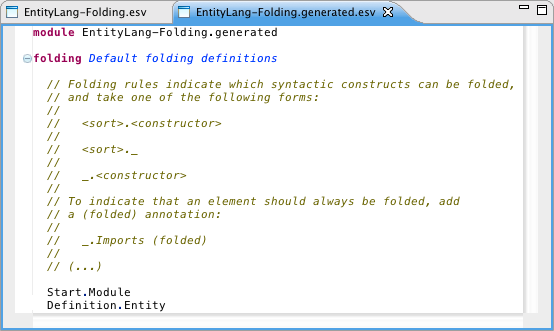 The default EntityLang-Folding.generated.esv file defines folding for the start production (symbol Start, constructor label Module) and for entity definitions.
All editor services follow the same basic structure: they have a definition file (EntityLang-Folding.esv) and a derived file (EntityLang-Folding.generated.esv). The first file can be used to customize the editor. The second file is automatically generated from your grammar, each time the project is built.
The default EntityLang-Folding.generated.esv file defines folding for the start production (symbol Start, constructor label Module) and for entity definitions.
All editor services follow the same basic structure: they have a definition file (EntityLang-Folding.esv) and a derived file (EntityLang-Folding.generated.esv). The first file can be used to customize the editor. The second file is automatically generated from your grammar, each time the project is built.
 An interesting feature of the outline is that it can be shown in the quick outline view by pressing control-O (command-O on Mac OSX). This allows users to quickly navigate in the file:
An interesting feature of the outline is that it can be shown in the quick outline view by pressing control-O (command-O on Mac OSX). This allows users to quickly navigate in the file:
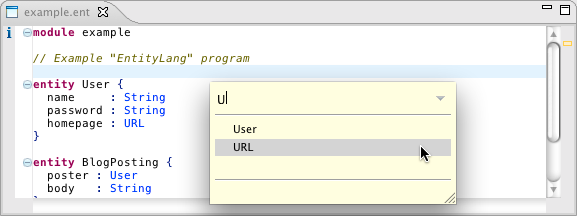
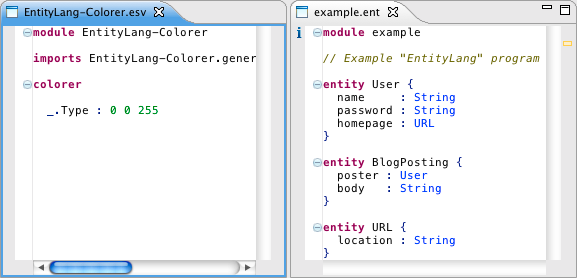
 These generate Java code directly from the abstract syntax of the language. Each takes the following form:
These generate Java code directly from the abstract syntax of the language. Each takes the following form:
 If you edit the input text, the transformation result will be automatically updated. Try changing the transformation and rebuilding the project.
If you edit the input text, the transformation result will be automatically updated. Try changing the transformation and rebuilding the project.
 This rule rewrites the CompositeProperty we have shown before to a regular property. We can now rebuild the project and try out the transformation. Select a composite entity property in the editor or abstract syntax view and choose Apply custom rule in the Transform menu:
This rule rewrites the CompositeProperty we have shown before to a regular property. We can now rebuild the project and try out the transformation. Select a composite entity property in the editor or abstract syntax view and choose Apply custom rule in the Transform menu:
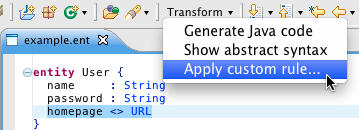 When prompted, enter the name of the simplify rule:
When prompted, enter the name of the simplify rule:
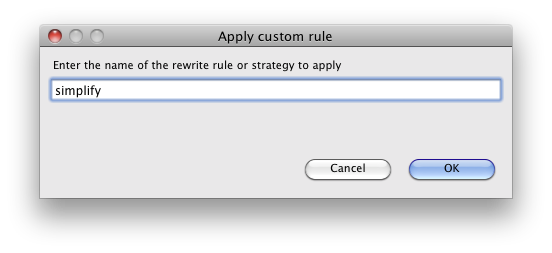 The result of our transformation is now shown in an a view to the side:
The result of our transformation is now shown in an a view to the side:
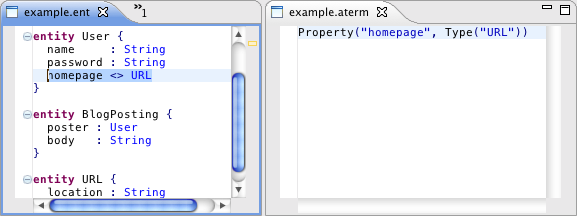 To use the simplify rule in our transformation to Java, we must make sure that it is invoked there. The original to-java rule was invoked in entitylang.str, which defines the main interface of our language for the editor:
To use the simplify rule in our transformation to Java, we must make sure that it is invoked there. The original to-java rule was invoked in entitylang.str, which defines the main interface of our language for the editor:
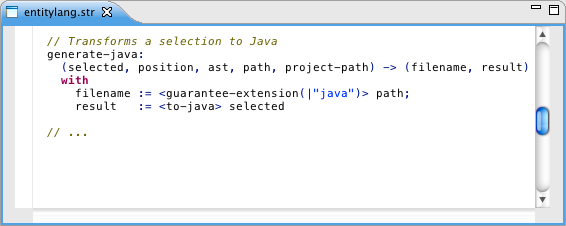 This rule follows a fixed interface for interoperability with the editor, and gets the node currently selected by the user, its tree position as a list of indices, the complete ast of the file, and the path of the file. As a result, it returns a tuple of a filename that should be generated and its contents.
We can adapt the generate-java rule to call our new simplify rule:
This rule follows a fixed interface for interoperability with the editor, and gets the node currently selected by the user, its tree position as a list of indices, the complete ast of the file, and the path of the file. As a result, it returns a tuple of a filename that should be generated and its contents.
We can adapt the generate-java rule to call our new simplify rule:
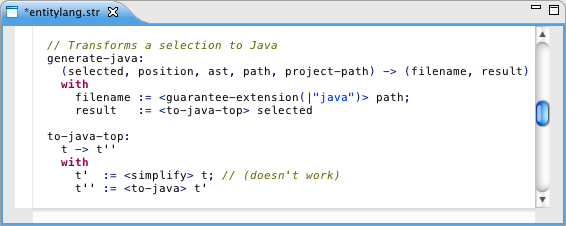 We added a new rule to-java-top that first invokes the simplify rule before to-java is invoked. However, when you rebuild the project you will find that this adaptation does not work: the simplify rule cannot be applied to an entire module. Unlike to-java, it is only defined for CompositeProperty.
We can fix our transformation by introducing new definitions for the simplify rule for modules, entities, etc:
We added a new rule to-java-top that first invokes the simplify rule before to-java is invoked. However, when you rebuild the project you will find that this adaptation does not work: the simplify rule cannot be applied to an entire module. Unlike to-java, it is only defined for CompositeProperty.
We can fix our transformation by introducing new definitions for the simplify rule for modules, entities, etc:
 Unfortunately, this practice quickly becomes tedious and hard to maintain. Stratego also allows us to specify a strategy according to which the rule should be applied in the entire tree. A common strategy is the topdown/try strategy: walk the tree in a topdown fashion, and try to apply it everywhere in the tree where possible:
Unfortunately, this practice quickly becomes tedious and hard to maintain. Stratego also allows us to specify a strategy according to which the rule should be applied in the entire tree. A common strategy is the topdown/try strategy: walk the tree in a topdown fashion, and try to apply it everywhere in the tree where possible:
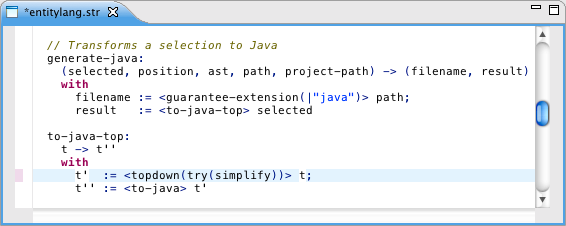 Other useful strategies are map, to apply a rule on a list (e.g., map(simplify)), and innermost, to exhaustively apply a rule, starting at the innermost leaves of a tree.
Other useful strategies are map, to apply a rule on a list (e.g., map(simplify)), and innermost, to exhaustively apply a rule, starting at the innermost leaves of a tree.
 Transform can be used directly in an editor of your language, but also from the abstract syntax of that language.
The EntityLang-Builders.esv file in the editor directory defines the entries in the Transform menu:
Transform can be used directly in an editor of your language, but also from the abstract syntax of that language.
The EntityLang-Builders.esv file in the editor directory defines the entries in the Transform menu:
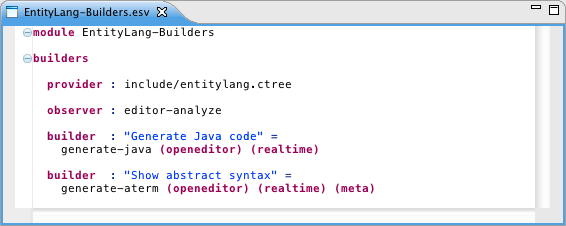 The corresponding EntityLang-Builders.generated.esv documents the definitions in this file. For this tour, we are interested in the builder definitions, which control the Transform menu items. The first builder specifies the "Generate Java code" item. It indicates that the generate-java rule that we saw before is responsible for this action. Using annotations, it also specifies that this action opens an editor which will be updated in "real time" as the user edits the source of the tranformation. The second builder is a meta builder: it only shows up to developers of the language, not when the plugin is deployed.
The corresponding EntityLang-Builders.generated.esv documents the definitions in this file. For this tour, we are interested in the builder definitions, which control the Transform menu items. The first builder specifies the "Generate Java code" item. It indicates that the generate-java rule that we saw before is responsible for this action. Using annotations, it also specifies that this action opens an editor which will be updated in "real time" as the user edits the source of the tranformation. The second builder is a meta builder: it only shows up to developers of the language, not when the plugin is deployed.
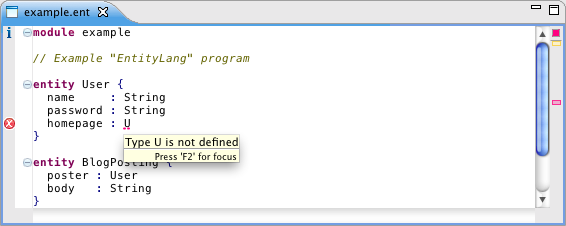 These errors are specified using check rules in the check.str file in the trans directory:
These errors are specified using check rules in the check.str file in the trans directory:
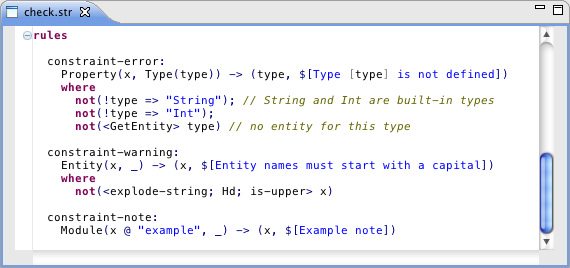 Like code generation rules, these rules are really just regular rewrite rules. They match against a particular language element and produce a tuple of the offending language element (where the error marker will be shown) and the error message.
The first definition of constraint-error matches properties where a particular condition holds (note the use of the where keyword): the property type is not "String" or "Int", and using GetEntity (defined below) we can tell that it does not exist in the symbol table.
Like code generation rules, these rules are really just regular rewrite rules. They match against a particular language element and produce a tuple of the offending language element (where the error marker will be shown) and the error message.
The first definition of constraint-error matches properties where a particular condition holds (note the use of the where keyword): the property type is not "String" or "Int", and using GetEntity (defined below) we can tell that it does not exist in the symbol table.

 The given refactoring specifies the "Rename" menu item, which is enabled in case an ID node is selected.The menu action is bind to the rename shortcut (Shift+Alt+R). After the user applies the rename refactoring, a dialog is prompted with an input field labeled "New name" that has the empty string as initial value.
The given refactoring specifies the "Rename" menu item, which is enabled in case an ID node is selected.The menu action is bind to the rename shortcut (Shift+Alt+R). After the user applies the rename refactoring, a dialog is prompted with an input field labeled "New name" that has the empty string as initial value.
 The OK button of the dialog triggers the action defined with the rename rule that we discuss in the next paragraph.
The OK button of the dialog triggers the action defined with the rename rule that we discuss in the next paragraph.
 This rule follows a fixed interface for interoperability with the editor. The left-hand-side of the rule is a tuple of: the result of the user input dialog, the selected node, its tree position, the complete ast of the file, the file path and the project path. The right-hand-side is a tuple containing the refactoring output: a list of node changes, plus lists with errors and warnings that will be reported to the user. Errors and warnings are specified as a tuple of the offending language element (which location will be reported) and the error message itself.
This rule follows a fixed interface for interoperability with the editor. The left-hand-side of the rule is a tuple of: the result of the user input dialog, the selected node, its tree position, the complete ast of the file, the file path and the project path. The right-hand-side is a tuple containing the refactoring output: a list of node changes, plus lists with errors and warnings that will be reported to the user. Errors and warnings are specified as a tuple of the offending language element (which location will be reported) and the error message itself.

 The analyze rule uses the topdown/try strategy we have shown before. It will try to apply the record-entity rule wherever it can. The record-entity rule is applied to all entities: User, BlogPosting, and URL. Stratego provides a concise notation for creating symbol tables: using the rules keyword, we define a new entry for the name 'x' that points to the node in the abstract syntax tree that defines it. We use this definition for error checking, reference resolving, and content completion.
The analyze rule uses the topdown/try strategy we have shown before. It will try to apply the record-entity rule wherever it can. The record-entity rule is applied to all entities: User, BlogPosting, and URL. Stratego provides a concise notation for creating symbol tables: using the rules keyword, we define a new entry for the name 'x' that points to the node in the abstract syntax tree that defines it. We use this definition for error checking, reference resolving, and content completion.
 Supporting reference resolving is easy once a program analysis is performed. By default, the entities language simply invokes the GetEntity rule to fetch the definition for any Type selected by the user:
Supporting reference resolving is easy once a program analysis is performed. By default, the entities language simply invokes the GetEntity rule to fetch the definition for any Type selected by the user:
 This rule follows the same structure as other rules in this file. It first prints a debugging message "Resolve: ...", which shows up in the Eclipse console (but not when the plugin is deployed). It then tries to set a variable type using the node that was just selected by the user. If the node is of the form Type(_), then it will call the GetEntity rule to resolve the declaration of that type. Since editor-resolve uses a where clause, it will only succeed if node is in fact a Type and if GetEntity succeeds. If this is not the case, another definition may of editor-resolve may be used instead, if one exists.
This rule follows the same structure as other rules in this file. It first prints a debugging message "Resolve: ...", which shows up in the Eclipse console (but not when the plugin is deployed). It then tries to set a variable type using the node that was just selected by the user. If the node is of the form Type(_), then it will call the GetEntity rule to resolve the declaration of that type. Since editor-resolve uses a where clause, it will only succeed if node is in fact a Type and if GetEntity succeeds. If this is not the case, another definition may of editor-resolve may be used instead, if one exists.
 Content completion can also be triggered when the user enters a particular sequence of characters (like the . in Java). The EntitityLang-Completions.esv allows this behavior to be configured:
Content completion can also be triggered when the user enters a particular sequence of characters (like the . in Java). The EntitityLang-Completions.esv allows this behavior to be configured:
 This file specifies that content completion should be triggered once users enter ": ". It also says that the editor-complete rule handles the implementation of content completion.
Like other editor services in Spoofax, content completion is implemented at the abstract syntax level. Once content completion is triggered, an AST like the following is created:
This file specifies that content completion should be triggered once users enter ": ". It also says that the editor-complete rule handles the implementation of content completion.
Like other editor services in Spoofax, content completion is implemented at the abstract syntax level. Once content completion is triggered, an AST like the following is created:
 In this AST we see a special COMPLETION(_) note where content completion is requested. The editor-complete rule in entity-lang.str provides completion proposals:
In this AST we see a special COMPLETION(_) note where content completion is requested. The editor-complete rule in entity-lang.str provides completion proposals:
 This rule gets the current abstract syntax tree node, its position, etc. and returns a list of content proposals. The "String" and "Int" proposal are hardcoded; other proposals are computed by taking all the keys of our GetEntity table. For this we use the all-keys-GetEntity rule which is automatically made available from our GetEntity definition. Spoofax will then automatically show proposals with the right prefix (here the letter "U").
This rule gets the current abstract syntax tree node, its position, etc. and returns a list of content proposals. The "String" and "Int" proposal are hardcoded; other proposals are computed by taking all the keys of our GetEntity table. For this we use the all-keys-GetEntity rule which is automatically made available from our GetEntity definition. Spoofax will then automatically show proposals with the right prefix (here the letter "U").
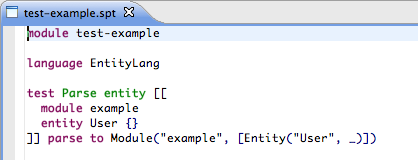 It specifies the name of the language under test (
It specifies the name of the language under test (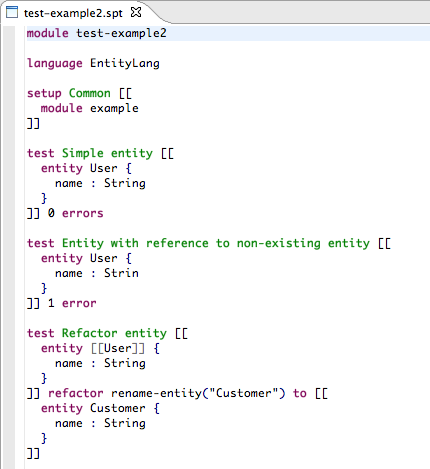 These test cases test for semantic errors (
These test cases test for semantic errors (
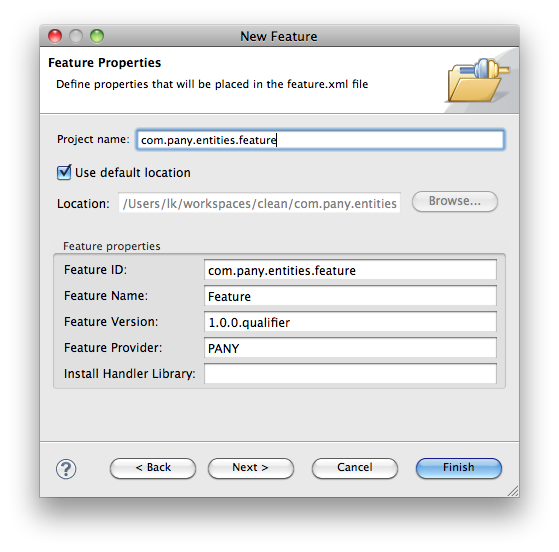 In the tab plugins, add your plugin to the list of included features using the "Add" button.
In the tab Included Features you should add Spoofax/IMP. Be sure you select that it can be updated from "both" update sites for maximal compatibility with existing installations and updates:
In the tab plugins, add your plugin to the list of included features using the "Add" button.
In the tab Included Features you should add Spoofax/IMP. Be sure you select that it can be updated from "both" update sites for maximal compatibility with existing installations and updates:
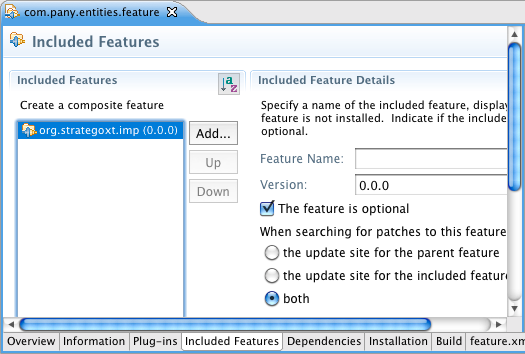 You can then create an update site project. From Overview page of feature.xml, open the New Update Site wizard:
You can then create an update site project. From Overview page of feature.xml, open the New Update Site wizard:
 As the name of the update site you may use company.entities.updatesite. In the update site project, create a new category and add the feature project:
As the name of the update site you may use company.entities.updatesite. In the update site project, create a new category and add the feature project:
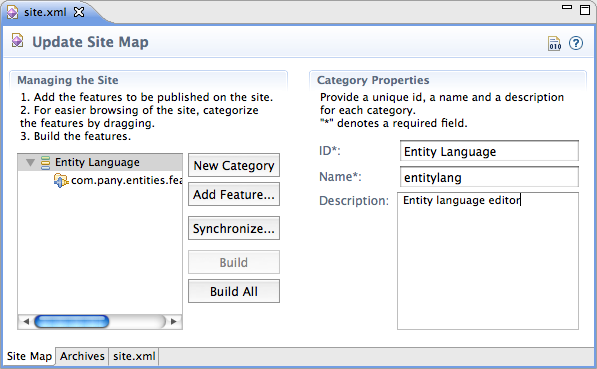 From here, you can select Build All to build the update site. You can then upload it to a web server and use it to install or update your plugin using the Eclipse update manager.
From here, you can select Build All to build the update site. You can then upload it to a web server and use it to install or update your plugin using the Eclipse update manager.
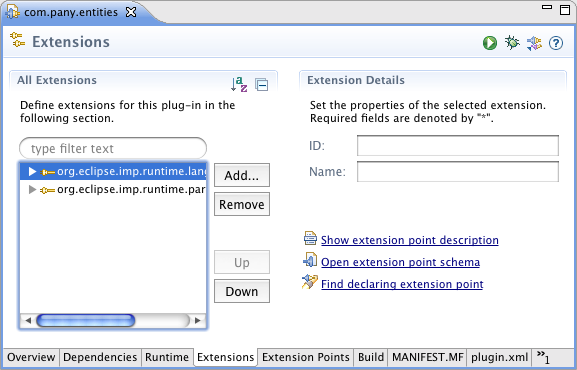 You can then select Add to add a new extension:
You can then select Add to add a new extension:
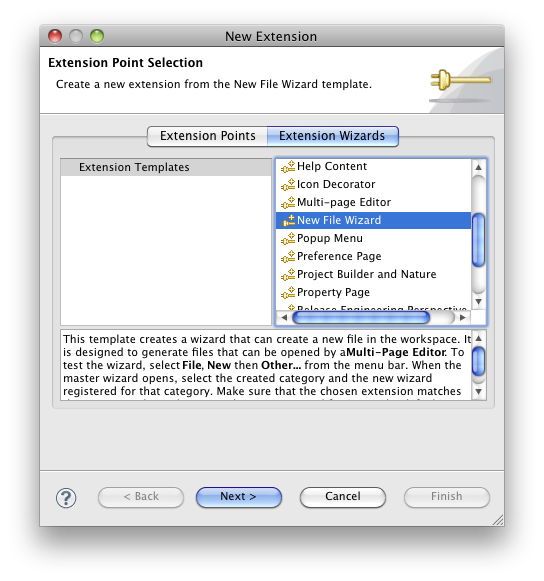 Note that only editor components defined using Spoofax/IMP can be used directly in the same Eclipse instance in which they are developed. Normal Eclipse plugins and extensions do not have this feature. You can try your Java-based extensions using the debug or run buttons in the tool bar, launching a new Eclipse instance:
Note that only editor components defined using Spoofax/IMP can be used directly in the same Eclipse instance in which they are developed. Normal Eclipse plugins and extensions do not have this feature. You can try your Java-based extensions using the debug or run buttons in the tool bar, launching a new Eclipse instance:
 A key class for integrating with Spoofax editors from Java org.strategoxt.imp.runtime.EditorState class, which provides things like the current or selection AST of an open editor. It also allows model listeners to be attached using EditorState.getEditor().addModelListener(). Please contact us if you have any questions about Java integration or other topics; we'd be happy to help.
All built-in Spoofax/IMP editor components are based on the Eclipse IMP framework. In addition to standard Eclipse plugin extensions, IMP can also be used to define parts of your editor. These can be created using the File > New wizard, selecting any of the IDE Language Support options. At this time, however, not all these wizards are stable, and they may not always work right within the Spoofax/IMP environment. Instead, we recommend that users build editor services using the Spoofax-native esv definitions or, if necessary, using regular Eclipse extension points.
A key class for integrating with Spoofax editors from Java org.strategoxt.imp.runtime.EditorState class, which provides things like the current or selection AST of an open editor. It also allows model listeners to be attached using EditorState.getEditor().addModelListener(). Please contact us if you have any questions about Java integration or other topics; we'd be happy to help.
All built-in Spoofax/IMP editor components are based on the Eclipse IMP framework. In addition to standard Eclipse plugin extensions, IMP can also be used to define parts of your editor. These can be created using the File > New wizard, selecting any of the IDE Language Support options. At this time, however, not all these wizards are stable, and they may not always work right within the Spoofax/IMP environment. Instead, we recommend that users build editor services using the Spoofax-native esv definitions or, if necessary, using regular Eclipse extension points.
| Tip: We provide general Spoofax usage tips using boxes like this one throughout this tour. |
Installation
Moved to http://metaborg.org/wiki/spoofax/downloadGetting Started
To get started, create a new Spoofax/IMP project using the File > New > Project > Spoofax/IMP project wizard. The wizard creates a new an example language and editor definition. It also opens editors for the crucial parts of these definitions, as illustrated below:
The wizard creates a new an example language and editor definition. It also opens editors for the crucial parts of these definitions, as illustrated below:
 Highlighted in blue are components that can be used to customize the language and editor. Key components (show in tabs, from left to right) are the SDF syntax of the language, the main editor descriptor, and the Stratego semantic description. The wizard also opens an editor with an example file that can be used to try out the language editor.
We recommend you glance the files in the project to get an idea of what function they have. The wizard filled in some default content that can be edited. Other files are derived files: in particular, all files with
Highlighted in blue are components that can be used to customize the language and editor. Key components (show in tabs, from left to right) are the SDF syntax of the language, the main editor descriptor, and the Stratego semantic description. The wizard also opens an editor with an example file that can be used to try out the language editor.
We recommend you glance the files in the project to get an idea of what function they have. The wizard filled in some default content that can be edited. Other files are derived files: in particular, all files with .generated in their name are derived from the language definition. These files should not be edited directly as they are generated every time the project is built.
| Tip: To rebuild the language and editor at any point use Project > Build Project (control-alt-B) or right-click on the build.main.xml file and run it using Ant. |
The syntax definition
The SDF grammar in thesyntax directory defines the syntactic structure of the language:
 The easiest way to work with the syntax may be to look at it side-by-side with an example editor, allowing you to experiment with the grammar and a concrete file.
The easiest way to work with the syntax may be to look at it side-by-side with an example editor, allowing you to experiment with the grammar and a concrete file.
| Tip: To show two editors side-by-side in Eclipse, drag their caption to a position adjacent to another editor. |
module keyword, and productions for entities, properties, and types. SDF productions take the following format:
p* -> S {a*}
And specify that a pattern p* reduces to a symbol S (sometimes called a sort). Using annotations a*, the abstract syntax and exact behavior of the production may be customized. In particular, we use the cons("Name") to specify that "Name" should be used to label the abstract syntax tree node. The abstract syntax is relevant for code generation and analysis of the language. We revisit this topic further on in this section.
To best get a feel of the SDF grammar formalism, try adding a new production to the language. For example, add a new kind of entity property that has a different (composite) relation to its type:
ID "<>" Type -> Property {cons("CompositeProperty")}
Note how SDF just allows you to add an additional case to the Property symbol. SDF can be used to modularly reuse and extend existing grammars in this fashion. The constructor label "CompositeProperty" is used to uniquely identify this new property relation. To try it out, rebuild your project (using control-alt-B), and use it in the example editor.
| Tip: For more information on using the SDF, see the reference manual on the Documentation page. |
The abstract syntax
Spoofax can show the abstract syntax of your program as textual terms. These are efficiently stored in memory and allow you to concisely manipulate programs. To inspect the abstract syntax of a file, select Show abstract syntax from the Transform menu: An extra editor will be opened to the side showing the abstract syntax of your file or selection. Note that the view is updated as the original file is edited.
An extra editor will be opened to the side showing the abstract syntax of your file or selection. Note that the view is updated as the original file is edited.
Presentational editor services
Presentational editor services such as code folding, the outline view, and syntax highlighting are defined using esv files in the editor directory.Code folding
As an example, we take a look at the definition for code folding: The default EntityLang-Folding.generated.esv file defines folding for the start production (symbol Start, constructor label Module) and for entity definitions.
All editor services follow the same basic structure: they have a definition file (EntityLang-Folding.esv) and a derived file (EntityLang-Folding.generated.esv). The first file can be used to customize the editor. The second file is automatically generated from your grammar, each time the project is built.
The default EntityLang-Folding.generated.esv file defines folding for the start production (symbol Start, constructor label Module) and for entity definitions.
All editor services follow the same basic structure: they have a definition file (EntityLang-Folding.esv) and a derived file (EntityLang-Folding.generated.esv). The first file can be used to customize the editor. The second file is automatically generated from your grammar, each time the project is built.
| Tip: The .generated files document the editor descriptor languages using comments. |
Outline view
The outline view of the editor can be customized in the same way as the folding definition: An interesting feature of the outline is that it can be shown in the quick outline view by pressing control-O (command-O on Mac OSX). This allows users to quickly navigate in the file:
An interesting feature of the outline is that it can be shown in the quick outline view by pressing control-O (command-O on Mac OSX). This allows users to quickly navigate in the file:

Syntax highlighting
We can use the EntityLang-Colorer file to customize the generated syntax highlighter:
Transformations and code generation
The generate.str file in the trans directory defines code generation rules: These generate Java code directly from the abstract syntax of the language. Each takes the following form:
These generate Java code directly from the abstract syntax of the language. Each takes the following form:
name:
T1 -> T2
with
x := y;
...
A rule of this form rewrites a subtree of form T1 to T2. In the optional with clause of the rule, variables can be assigned and other rules can be invoked. Some rules specify a where clause with a condition for the rewrite rule.
The rules in our example directly rewrite to Java code using string interpolation to construct Java as text fragments. String interpolation allows you to combine text with variables. Any indentation you use is preserved in the end result, minus the indentation leading up to the quotation. This means your code looks pretty both when you write it and when it comes out of the generator. You can use string interpolation using the $[ ... ] brackets. Variables can be inserted using brackets without a dollar: [ ... ]. If you want, you can also use any other kind of bracket: {, <, and ( are allowed.
You can try out the transformation using the Transform menu, selecting Generate Java code:
 If you edit the input text, the transformation result will be automatically updated. Try changing the transformation and rebuilding the project.
If you edit the input text, the transformation result will be automatically updated. Try changing the transformation and rebuilding the project.
Advanced transformations
When you implement more complicated transformations you will find that it is easier to use intermediate rewrite rules instead that rewrite entity ASTs to simpler entity ASTs (sometimes called model transformations or desugarings). To accomplish this, you can add additional definitions for the to-java rule, or you can add a new rule with a different name: This rule rewrites the CompositeProperty we have shown before to a regular property. We can now rebuild the project and try out the transformation. Select a composite entity property in the editor or abstract syntax view and choose Apply custom rule in the Transform menu:
This rule rewrites the CompositeProperty we have shown before to a regular property. We can now rebuild the project and try out the transformation. Select a composite entity property in the editor or abstract syntax view and choose Apply custom rule in the Transform menu:
 When prompted, enter the name of the simplify rule:
When prompted, enter the name of the simplify rule:
 The result of our transformation is now shown in an a view to the side:
The result of our transformation is now shown in an a view to the side:
 To use the simplify rule in our transformation to Java, we must make sure that it is invoked there. The original to-java rule was invoked in entitylang.str, which defines the main interface of our language for the editor:
To use the simplify rule in our transformation to Java, we must make sure that it is invoked there. The original to-java rule was invoked in entitylang.str, which defines the main interface of our language for the editor:
 This rule follows a fixed interface for interoperability with the editor, and gets the node currently selected by the user, its tree position as a list of indices, the complete ast of the file, and the path of the file. As a result, it returns a tuple of a filename that should be generated and its contents.
We can adapt the generate-java rule to call our new simplify rule:
This rule follows a fixed interface for interoperability with the editor, and gets the node currently selected by the user, its tree position as a list of indices, the complete ast of the file, and the path of the file. As a result, it returns a tuple of a filename that should be generated and its contents.
We can adapt the generate-java rule to call our new simplify rule:
 We added a new rule to-java-top that first invokes the simplify rule before to-java is invoked. However, when you rebuild the project you will find that this adaptation does not work: the simplify rule cannot be applied to an entire module. Unlike to-java, it is only defined for CompositeProperty.
We can fix our transformation by introducing new definitions for the simplify rule for modules, entities, etc:
We added a new rule to-java-top that first invokes the simplify rule before to-java is invoked. However, when you rebuild the project you will find that this adaptation does not work: the simplify rule cannot be applied to an entire module. Unlike to-java, it is only defined for CompositeProperty.
We can fix our transformation by introducing new definitions for the simplify rule for modules, entities, etc:
 Unfortunately, this practice quickly becomes tedious and hard to maintain. Stratego also allows us to specify a strategy according to which the rule should be applied in the entire tree. A common strategy is the topdown/try strategy: walk the tree in a topdown fashion, and try to apply it everywhere in the tree where possible:
Unfortunately, this practice quickly becomes tedious and hard to maintain. Stratego also allows us to specify a strategy according to which the rule should be applied in the entire tree. A common strategy is the topdown/try strategy: walk the tree in a topdown fashion, and try to apply it everywhere in the tree where possible:
 Other useful strategies are map, to apply a rule on a list (e.g., map(simplify)), and innermost, to exhaustively apply a rule, starting at the innermost leaves of a tree.
Other useful strategies are map, to apply a rule on a list (e.g., map(simplify)), and innermost, to exhaustively apply a rule, starting at the innermost leaves of a tree.
| Tip: For more information on using strategies and rewrite rules in Stratego, see the reference manual and tutorial on the Documentation page. |
Customizing the Transform menu
The Transform menu allows you to apply any rule to a file or selection: Transform can be used directly in an editor of your language, but also from the abstract syntax of that language.
The EntityLang-Builders.esv file in the editor directory defines the entries in the Transform menu:
Transform can be used directly in an editor of your language, but also from the abstract syntax of that language.
The EntityLang-Builders.esv file in the editor directory defines the entries in the Transform menu:
 The corresponding EntityLang-Builders.generated.esv documents the definitions in this file. For this tour, we are interested in the builder definitions, which control the Transform menu items. The first builder specifies the "Generate Java code" item. It indicates that the generate-java rule that we saw before is responsible for this action. Using annotations, it also specifies that this action opens an editor which will be updated in "real time" as the user edits the source of the tranformation. The second builder is a meta builder: it only shows up to developers of the language, not when the plugin is deployed.
The corresponding EntityLang-Builders.generated.esv documents the definitions in this file. For this tour, we are interested in the builder definitions, which control the Transform menu items. The first builder specifies the "Generate Java code" item. It indicates that the generate-java rule that we saw before is responsible for this action. Using annotations, it also specifies that this action opens an editor which will be updated in "real time" as the user edits the source of the tranformation. The second builder is a meta builder: it only shows up to developers of the language, not when the plugin is deployed.
Error checking
Any errors in the entities language are reported directly in the editor: These errors are specified using check rules in the check.str file in the trans directory:
These errors are specified using check rules in the check.str file in the trans directory:
 Like code generation rules, these rules are really just regular rewrite rules. They match against a particular language element and produce a tuple of the offending language element (where the error marker will be shown) and the error message.
The first definition of constraint-error matches properties where a particular condition holds (note the use of the where keyword): the property type is not "String" or "Int", and using GetEntity (defined below) we can tell that it does not exist in the symbol table.
Like code generation rules, these rules are really just regular rewrite rules. They match against a particular language element and produce a tuple of the offending language element (where the error marker will be shown) and the error message.
The first definition of constraint-error matches properties where a particular condition holds (note the use of the where keyword): the property type is not "String" or "Int", and using GetEntity (defined below) we can tell that it does not exist in the symbol table.
Refactorings
Spoofax helps you to enrich your editor with refactorings. You can find the refactorings in the context menu of the file being edited.
Refactoring Specifications
The EntityLang-Builders.esv file in the editor directory defines the entries in the Refactor menu: The given refactoring specifies the "Rename" menu item, which is enabled in case an ID node is selected.The menu action is bind to the rename shortcut (Shift+Alt+R). After the user applies the rename refactoring, a dialog is prompted with an input field labeled "New name" that has the empty string as initial value.
The given refactoring specifies the "Rename" menu item, which is enabled in case an ID node is selected.The menu action is bind to the rename shortcut (Shift+Alt+R). After the user applies the rename refactoring, a dialog is prompted with an input field labeled "New name" that has the empty string as initial value.
 The OK button of the dialog triggers the action defined with the rename rule that we discuss in the next paragraph.
The OK button of the dialog triggers the action defined with the rename rule that we discuss in the next paragraph.
Refactoring Transformations
Refactorings are defined in Stratego. The refactor.str file in the trans directory defines the renaming refactoring for the entity language. This rule follows a fixed interface for interoperability with the editor. The left-hand-side of the rule is a tuple of: the result of the user input dialog, the selected node, its tree position, the complete ast of the file, the file path and the project path. The right-hand-side is a tuple containing the refactoring output: a list of node changes, plus lists with errors and warnings that will be reported to the user. Errors and warnings are specified as a tuple of the offending language element (which location will be reported) and the error message itself.
This rule follows a fixed interface for interoperability with the editor. The left-hand-side of the rule is a tuple of: the result of the user input dialog, the selected node, its tree position, the complete ast of the file, the file path and the project path. The right-hand-side is a tuple containing the refactoring output: a list of node changes, plus lists with errors and warnings that will be reported to the user. Errors and warnings are specified as a tuple of the offending language element (which location will be reported) and the error message itself.

| Tip: multiple-file refactorings can be specified in the change list using the root nodes: [(ast-1-before, ast-1-after), (ast-2-before, ast-2-after), ...] |
Program analysis
We use a symbol table as the basis for our semantic analysis. Every entity is stored in this table, mapping its name to its definition. This table is defined in the record-entity rule in check.str: The analyze rule uses the topdown/try strategy we have shown before. It will try to apply the record-entity rule wherever it can. The record-entity rule is applied to all entities: User, BlogPosting, and URL. Stratego provides a concise notation for creating symbol tables: using the rules keyword, we define a new entry for the name 'x' that points to the node in the abstract syntax tree that defines it. We use this definition for error checking, reference resolving, and content completion.
The analyze rule uses the topdown/try strategy we have shown before. It will try to apply the record-entity rule wherever it can. The record-entity rule is applied to all entities: User, BlogPosting, and URL. Stratego provides a concise notation for creating symbol tables: using the rules keyword, we define a new entry for the name 'x' that points to the node in the abstract syntax tree that defines it. We use this definition for error checking, reference resolving, and content completion.
Reference resolving
When a user holds control (or command on Mac OSX) and hovers over an identifier, they get a link to its definition: Supporting reference resolving is easy once a program analysis is performed. By default, the entities language simply invokes the GetEntity rule to fetch the definition for any Type selected by the user:
Supporting reference resolving is easy once a program analysis is performed. By default, the entities language simply invokes the GetEntity rule to fetch the definition for any Type selected by the user:
 This rule follows the same structure as other rules in this file. It first prints a debugging message "Resolve: ...", which shows up in the Eclipse console (but not when the plugin is deployed). It then tries to set a variable type using the node that was just selected by the user. If the node is of the form Type(_), then it will call the GetEntity rule to resolve the declaration of that type. Since editor-resolve uses a where clause, it will only succeed if node is in fact a Type and if GetEntity succeeds. If this is not the case, another definition may of editor-resolve may be used instead, if one exists.
This rule follows the same structure as other rules in this file. It first prints a debugging message "Resolve: ...", which shows up in the Eclipse console (but not when the plugin is deployed). It then tries to set a variable type using the node that was just selected by the user. If the node is of the form Type(_), then it will call the GetEntity rule to resolve the declaration of that type. Since editor-resolve uses a where clause, it will only succeed if node is in fact a Type and if GetEntity succeeds. If this is not the case, another definition may of editor-resolve may be used instead, if one exists.
Content completion
Spoofax supports content completion that can be triggered by pressing control-space: Content completion can also be triggered when the user enters a particular sequence of characters (like the . in Java). The EntitityLang-Completions.esv allows this behavior to be configured:
Content completion can also be triggered when the user enters a particular sequence of characters (like the . in Java). The EntitityLang-Completions.esv allows this behavior to be configured:
 This file specifies that content completion should be triggered once users enter ": ". It also says that the editor-complete rule handles the implementation of content completion.
Like other editor services in Spoofax, content completion is implemented at the abstract syntax level. Once content completion is triggered, an AST like the following is created:
This file specifies that content completion should be triggered once users enter ": ". It also says that the editor-complete rule handles the implementation of content completion.
Like other editor services in Spoofax, content completion is implemented at the abstract syntax level. Once content completion is triggered, an AST like the following is created:
 In this AST we see a special COMPLETION(_) note where content completion is requested. The editor-complete rule in entity-lang.str provides completion proposals:
In this AST we see a special COMPLETION(_) note where content completion is requested. The editor-complete rule in entity-lang.str provides completion proposals:
 This rule gets the current abstract syntax tree node, its position, etc. and returns a list of content proposals. The "String" and "Int" proposal are hardcoded; other proposals are computed by taking all the keys of our GetEntity table. For this we use the all-keys-GetEntity rule which is automatically made available from our GetEntity definition. Spoofax will then automatically show proposals with the right prefix (here the letter "U").
This rule gets the current abstract syntax tree node, its position, etc. and returns a list of content proposals. The "String" and "Int" proposal are hardcoded; other proposals are computed by taking all the keys of our GetEntity table. For this we use the all-keys-GetEntity rule which is automatically made available from our GetEntity definition. Spoofax will then automatically show proposals with the right prefix (here the letter "U").
Testing Language Definitions
Spoofax allows you to write tests for your language implementation using a specialized testing language. An example set of tests can be found intest/test-example.spt.
A basic testing module has the following form, specifying the name of a language:
 It specifies the name of the language under test (
It specifies the name of the language under test (EntityLang) and one or more test cases. The test case in this module is based on a small EntityLang program enclosed in ? brackets, and specifies that this program should parse to a pattern Module("example", [Entity("User", _)]).
More advanced test cases may use setup blocks to factor out commonalities in test cases, and can specify a wide range of testing conditions:
 These test cases test for semantic errors (
These test cases test for semantic errors (0 errors or 1 error) and test that refactoring works as expected. Notice how the last test case uses the ? brackets to indicate that a rename refactoring is performed on the "User" entity. This test case simulates the renaming of the "User" entity to a "Customer" entity.
Any failing test cases are marked with an error in the editor. The "Transform" menu can also be used to launch a project-wide, graphical test runner:

| Tip: content completion shows more conditions that can be specified for test cases. A full overview is also given in the paper Integrated Language Definition Testing. |
Plugin deployment
You can deploy your plugin using the Eclipse update site mechanism. Users do not need to have Spoofax/IMP installed for using your plugin. To create an update site, you need to create a plugin feature project and an update site project. You can create a new plugin feature project by using the File > New > Project > Plug-in development > Feature Project wizard: In the tab plugins, add your plugin to the list of included features using the "Add" button.
In the tab Included Features you should add Spoofax/IMP. Be sure you select that it can be updated from "both" update sites for maximal compatibility with existing installations and updates:
In the tab plugins, add your plugin to the list of included features using the "Add" button.
In the tab Included Features you should add Spoofax/IMP. Be sure you select that it can be updated from "both" update sites for maximal compatibility with existing installations and updates:
 You can then create an update site project. From Overview page of feature.xml, open the New Update Site wizard:
You can then create an update site project. From Overview page of feature.xml, open the New Update Site wizard:
 As the name of the update site you may use company.entities.updatesite. In the update site project, create a new category and add the feature project:
As the name of the update site you may use company.entities.updatesite. In the update site project, create a new category and add the feature project:
 From here, you can select Build All to build the update site. You can then upload it to a web server and use it to install or update your plugin using the Eclipse update manager.
From here, you can select Build All to build the update site. You can then upload it to a web server and use it to install or update your plugin using the Eclipse update manager.
Adding Java components
Some advanced users may want to add their own Java components to their plugins. Spoofax provides two mechanisms for interoperation with Java and other JVM-based languages. The first mechanism is the standard Eclipse extension mechanism: as the Spoofax framework is based on Java and Eclipse, it allows you to add new, Java-based components as Eclipse extensions. The other mechanism is that it allows users to implement their own strategies (functions that follow the Stratego interface) using Java. This mechanism is documented in the editor/java/.../strategies/java_strategy_0_0.java example strategy included with the default project. Strategies implemented this way can be dynamically loaded just like other Spoofax components. In this tour we focus on the Eclipse extension mechanism. These components can be added using the Extensions tab of plugin.xml: You can then select Add to add a new extension:
You can then select Add to add a new extension:
 Note that only editor components defined using Spoofax/IMP can be used directly in the same Eclipse instance in which they are developed. Normal Eclipse plugins and extensions do not have this feature. You can try your Java-based extensions using the debug or run buttons in the tool bar, launching a new Eclipse instance:
Note that only editor components defined using Spoofax/IMP can be used directly in the same Eclipse instance in which they are developed. Normal Eclipse plugins and extensions do not have this feature. You can try your Java-based extensions using the debug or run buttons in the tool bar, launching a new Eclipse instance:
 A key class for integrating with Spoofax editors from Java org.strategoxt.imp.runtime.EditorState class, which provides things like the current or selection AST of an open editor. It also allows model listeners to be attached using EditorState.getEditor().addModelListener(). Please contact us if you have any questions about Java integration or other topics; we'd be happy to help.
All built-in Spoofax/IMP editor components are based on the Eclipse IMP framework. In addition to standard Eclipse plugin extensions, IMP can also be used to define parts of your editor. These can be created using the File > New wizard, selecting any of the IDE Language Support options. At this time, however, not all these wizards are stable, and they may not always work right within the Spoofax/IMP environment. Instead, we recommend that users build editor services using the Spoofax-native esv definitions or, if necessary, using regular Eclipse extension points.
A key class for integrating with Spoofax editors from Java org.strategoxt.imp.runtime.EditorState class, which provides things like the current or selection AST of an open editor. It also allows model listeners to be attached using EditorState.getEditor().addModelListener(). Please contact us if you have any questions about Java integration or other topics; we'd be happy to help.
All built-in Spoofax/IMP editor components are based on the Eclipse IMP framework. In addition to standard Eclipse plugin extensions, IMP can also be used to define parts of your editor. These can be created using the File > New wizard, selecting any of the IDE Language Support options. At this time, however, not all these wizards are stable, and they may not always work right within the Spoofax/IMP environment. Instead, we recommend that users build editor services using the Spoofax-native esv definitions or, if necessary, using regular Eclipse extension points.
| Topic | Changed | By |
|---|---|---|
| WebLeftBar | 11 May 2017 - 05:48 | EelcoVisser |
| CommandLine? | 12 Jun 2014 - 09:03 | VladVergu |
| Testing? | 13 Sep 2013 - 14:42 | EelcoVisser |
| News? | 25 Mar 2013 - 14:42 | LennartKats |
| NBL? | 25 Mar 2013 - 10:57 | EelcoVisser |
| Download? | 25 Mar 2013 - 10:56 | EelcoVisser |
| ChangeLog? | 22 Mar 2013 - 10:40 | LennartKats |
| SpoofaxRelease11? | 16 Feb 2013 - 16:40 | EelcoVisser |
| NaBL? | 14 Feb 2013 - 20:33 | EelcoVisser |
| DebugStratego? | 01 Feb 2013 - 09:14 | GuidoWachsmuth |
| SemanticIndex? | 01 Feb 2013 - 09:12 | GuidoWachsmuth |
| ContinuousBuildingSpoofax? | 01 Feb 2013 - 09:11 | GuidoWachsmuth |
| Development? | 28 Jan 2013 - 13:56 | EelcoVisser |
| Support? | 28 Jan 2013 - 13:06 | EelcoVisser |
| Documentation? | 22 Oct 2012 - 22:10 | EelcoVisser |
| FAQ? | 17 Oct 2012 - 12:28 | LennartKats |
| SummerSchool? | 23 Jul 2012 - 06:31 | GabrielKonat |
| TemplateLanguage? | 09 Apr 2012 - 04:45 | TobiVollebregt |
| SpoofaxLanguage? | 24 Mar 2012 - 14:30 | TobiVollebregt |
| WebHome | 24 Feb 2012 - 17:28 | LennartKats |
| Refactorings? | 26 Jan 2012 - 13:42 | MaartjeDeJonge |
| ExampleIni? | 21 Dec 2011 - 15:16 | LennartKats |
| TestingDemo? | 20 Dec 2011 - 14:51 | LennartKats |
| Research? | 18 Dec 2011 - 08:20 | MaartjeDeJonge |
| Tour? | 28 Nov 2011 - 14:37 | LennartKats |
| Features? | 27 Nov 2011 - 00:57 | MaartjeDeJonge |
| Examples? | 11 Oct 2011 - 16:01 | TobiVollebregt |
| LWC2011? | 24 May 2011 - 08:13 | LennartKats |
| LayoutPreservation? | 19 Nov 2010 - 21:45 | EelcoVisser |
| Devnology? | 06 Nov 2010 - 14:43 | LennartKats |
| InteractiveDisambiguation? | 27 Jun 2010 - 22:22 | LennartKats |
| NWL? | 06 May 2010 - 11:10 | LennartKats |
| Components? | 31 Mar 2010 - 15:02 | LennartKats |
| IMP? | 23 Feb 2010 - 10:23 | LennartKats |
| WebPreferences | 12 Feb 2010 - 14:50 | LennartKats |
| WebRss | 16 Aug 2004 - 03:27 | PeterThoeny |
| WebSearchAdvanced | 18 Jan 2004 - 10:52 | PeterThoeny |
| UpdateWebPages | 20 Sep 2002 - 08:37 | EelcoVisser |
| SiteMap | 27 Aug 2002 - 08:00 | EelcoVisser |
| WebChanges500 | 23 Apr 2002 - 20:09 | EelcoVisser |
| WebChanges200 | 23 Apr 2002 - 20:05 | EelcoVisser |
| WebChanges100 | 23 Apr 2002 - 19:53 | EelcoVisser |
| WebChanges | 23 Apr 2002 - 19:46 | EelcoVisser |
| WebNotify | 23 Jan 2002 - 14:21 | EelcoVisser |
| WebIndex | 23 Jan 2002 - 14:20 | EelcoVisser |
| WebNews | 23 Jan 2002 - 14:17 | EelcoVisser |
| WebTopicList | 24 Nov 2001 - 11:40 | PeterThoeny |
| WebTools | 08 Nov 2001 - 09:49 | TWikiGuest |
| WebSearch | 08 Aug 2001 - 05:26 | PeterThoeny |
| WebStatistics | 08 Aug 2001 - 05:25 | PeterThoeny |
| Topic | Changed | By |
|---|---|---|
| WebLeftBar | 11 May 2017 - 05:48 | EelcoVisser |
| CommandLine? | 12 Jun 2014 - 09:03 | VladVergu |
| Testing? | 13 Sep 2013 - 14:42 | EelcoVisser |
| News? | 25 Mar 2013 - 14:42 | LennartKats |
| NBL? | 25 Mar 2013 - 10:57 | EelcoVisser |
| Download? | 25 Mar 2013 - 10:56 | EelcoVisser |
| ChangeLog? | 22 Mar 2013 - 10:40 | LennartKats |
| SpoofaxRelease11? | 16 Feb 2013 - 16:40 | EelcoVisser |
| NaBL? | 14 Feb 2013 - 20:33 | EelcoVisser |
| DebugStratego? | 01 Feb 2013 - 09:14 | GuidoWachsmuth |
| SemanticIndex? | 01 Feb 2013 - 09:12 | GuidoWachsmuth |
| ContinuousBuildingSpoofax? | 01 Feb 2013 - 09:11 | GuidoWachsmuth |
| Development? | 28 Jan 2013 - 13:56 | EelcoVisser |
| Support? | 28 Jan 2013 - 13:06 | EelcoVisser |
| Documentation? | 22 Oct 2012 - 22:10 | EelcoVisser |
| FAQ? | 17 Oct 2012 - 12:28 | LennartKats |
| SummerSchool? | 23 Jul 2012 - 06:31 | GabrielKonat |
| TemplateLanguage? | 09 Apr 2012 - 04:45 | TobiVollebregt |
| SpoofaxLanguage? | 24 Mar 2012 - 14:30 | TobiVollebregt |
| WebHome | 24 Feb 2012 - 17:28 | LennartKats |
| Refactorings? | 26 Jan 2012 - 13:42 | MaartjeDeJonge |
| ExampleIni? | 21 Dec 2011 - 15:16 | LennartKats |
| TestingDemo? | 20 Dec 2011 - 14:51 | LennartKats |
| Research? | 18 Dec 2011 - 08:20 | MaartjeDeJonge |
| Tour? | 28 Nov 2011 - 14:37 | LennartKats |
| Features? | 27 Nov 2011 - 00:57 | MaartjeDeJonge |
| Examples? | 11 Oct 2011 - 16:01 | TobiVollebregt |
| LWC2011? | 24 May 2011 - 08:13 | LennartKats |
| LayoutPreservation? | 19 Nov 2010 - 21:45 | EelcoVisser |
| Devnology? | 06 Nov 2010 - 14:43 | LennartKats |
| InteractiveDisambiguation? | 27 Jun 2010 - 22:22 | LennartKats |
| NWL? | 06 May 2010 - 11:10 | LennartKats |
| Components? | 31 Mar 2010 - 15:02 | LennartKats |
| IMP? | 23 Feb 2010 - 10:23 | LennartKats |
| WebPreferences | 12 Feb 2010 - 14:50 | LennartKats |
| WebRss | 16 Aug 2004 - 03:27 | PeterThoeny |
| WebSearchAdvanced | 18 Jan 2004 - 10:52 | PeterThoeny |
| UpdateWebPages | 20 Sep 2002 - 08:37 | EelcoVisser |
| SiteMap | 27 Aug 2002 - 08:00 | EelcoVisser |
| WebChanges500 | 23 Apr 2002 - 20:09 | EelcoVisser |
| WebChanges200 | 23 Apr 2002 - 20:05 | EelcoVisser |
| WebChanges100 | 23 Apr 2002 - 19:53 | EelcoVisser |
| WebChanges | 23 Apr 2002 - 19:46 | EelcoVisser |
| WebNotify | 23 Jan 2002 - 14:21 | EelcoVisser |
| WebIndex | 23 Jan 2002 - 14:20 | EelcoVisser |
| WebNews | 23 Jan 2002 - 14:17 | EelcoVisser |
| WebTopicList | 24 Nov 2001 - 11:40 | PeterThoeny |
| WebTools | 08 Nov 2001 - 09:49 | TWikiGuest |
| WebSearch | 08 Aug 2001 - 05:26 | PeterThoeny |
| WebStatistics | 08 Aug 2001 - 05:25 | PeterThoeny |
| Topic | Changed | By |
|---|---|---|
| WebLeftBar | 11 May 2017 - 05:48 | EelcoVisser |
| CommandLine? | 12 Jun 2014 - 09:03 | VladVergu |
| Testing? | 13 Sep 2013 - 14:42 | EelcoVisser |
| News? | 25 Mar 2013 - 14:42 | LennartKats |
| NBL? | 25 Mar 2013 - 10:57 | EelcoVisser |
| Download? | 25 Mar 2013 - 10:56 | EelcoVisser |
| ChangeLog? | 22 Mar 2013 - 10:40 | LennartKats |
| SpoofaxRelease11? | 16 Feb 2013 - 16:40 | EelcoVisser |
| NaBL? | 14 Feb 2013 - 20:33 | EelcoVisser |
| DebugStratego? | 01 Feb 2013 - 09:14 | GuidoWachsmuth |
| SemanticIndex? | 01 Feb 2013 - 09:12 | GuidoWachsmuth |
| ContinuousBuildingSpoofax? | 01 Feb 2013 - 09:11 | GuidoWachsmuth |
| Development? | 28 Jan 2013 - 13:56 | EelcoVisser |
| Support? | 28 Jan 2013 - 13:06 | EelcoVisser |
| Documentation? | 22 Oct 2012 - 22:10 | EelcoVisser |
| FAQ? | 17 Oct 2012 - 12:28 | LennartKats |
| SummerSchool? | 23 Jul 2012 - 06:31 | GabrielKonat |
| TemplateLanguage? | 09 Apr 2012 - 04:45 | TobiVollebregt |
| SpoofaxLanguage? | 24 Mar 2012 - 14:30 | TobiVollebregt |
| WebHome | 24 Feb 2012 - 17:28 | LennartKats |
| Refactorings? | 26 Jan 2012 - 13:42 | MaartjeDeJonge |
| ExampleIni? | 21 Dec 2011 - 15:16 | LennartKats |
| TestingDemo? | 20 Dec 2011 - 14:51 | LennartKats |
| Research? | 18 Dec 2011 - 08:20 | MaartjeDeJonge |
| Tour? | 28 Nov 2011 - 14:37 | LennartKats |
| Features? | 27 Nov 2011 - 00:57 | MaartjeDeJonge |
| Examples? | 11 Oct 2011 - 16:01 | TobiVollebregt |
| LWC2011? | 24 May 2011 - 08:13 | LennartKats |
| LayoutPreservation? | 19 Nov 2010 - 21:45 | EelcoVisser |
| Devnology? | 06 Nov 2010 - 14:43 | LennartKats |
| InteractiveDisambiguation? | 27 Jun 2010 - 22:22 | LennartKats |
| NWL? | 06 May 2010 - 11:10 | LennartKats |
| Components? | 31 Mar 2010 - 15:02 | LennartKats |
| IMP? | 23 Feb 2010 - 10:23 | LennartKats |
| WebPreferences | 12 Feb 2010 - 14:50 | LennartKats |
| WebRss | 16 Aug 2004 - 03:27 | PeterThoeny |
| WebSearchAdvanced | 18 Jan 2004 - 10:52 | PeterThoeny |
| UpdateWebPages | 20 Sep 2002 - 08:37 | EelcoVisser |
| SiteMap | 27 Aug 2002 - 08:00 | EelcoVisser |
| WebChanges500 | 23 Apr 2002 - 20:09 | EelcoVisser |
| WebChanges200 | 23 Apr 2002 - 20:05 | EelcoVisser |
| WebChanges100 | 23 Apr 2002 - 19:53 | EelcoVisser |
| WebChanges | 23 Apr 2002 - 19:46 | EelcoVisser |
| WebNotify | 23 Jan 2002 - 14:21 | EelcoVisser |
| WebIndex | 23 Jan 2002 - 14:20 | EelcoVisser |
| WebNews | 23 Jan 2002 - 14:17 | EelcoVisser |
| WebTopicList | 24 Nov 2001 - 11:40 | PeterThoeny |
| WebTools | 08 Nov 2001 - 09:49 | TWikiGuest |
| WebSearch | 08 Aug 2001 - 05:26 | PeterThoeny |
| WebStatistics | 08 Aug 2001 - 05:25 | PeterThoeny |
| Topic | Changed | By |
|---|---|---|
| WebLeftBar | 11 May 2017 - 05:48 | EelcoVisser |
| CommandLine? | 12 Jun 2014 - 09:03 | VladVergu |
| Testing? | 13 Sep 2013 - 14:42 | EelcoVisser |
| News? | 25 Mar 2013 - 14:42 | LennartKats |
| NBL? | 25 Mar 2013 - 10:57 | EelcoVisser |
| Download? | 25 Mar 2013 - 10:56 | EelcoVisser |
| ChangeLog? | 22 Mar 2013 - 10:40 | LennartKats |
| SpoofaxRelease11? | 16 Feb 2013 - 16:40 | EelcoVisser |
| NaBL? | 14 Feb 2013 - 20:33 | EelcoVisser |
| DebugStratego? | 01 Feb 2013 - 09:14 | GuidoWachsmuth |
| SemanticIndex? | 01 Feb 2013 - 09:12 | GuidoWachsmuth |
| ContinuousBuildingSpoofax? | 01 Feb 2013 - 09:11 | GuidoWachsmuth |
| Development? | 28 Jan 2013 - 13:56 | EelcoVisser |
| Support? | 28 Jan 2013 - 13:06 | EelcoVisser |
| Documentation? | 22 Oct 2012 - 22:10 | EelcoVisser |
| FAQ? | 17 Oct 2012 - 12:28 | LennartKats |
| SummerSchool? | 23 Jul 2012 - 06:31 | GabrielKonat |
| TemplateLanguage? | 09 Apr 2012 - 04:45 | TobiVollebregt |
| SpoofaxLanguage? | 24 Mar 2012 - 14:30 | TobiVollebregt |
| WebHome | 24 Feb 2012 - 17:28 | LennartKats |
| Refactorings? | 26 Jan 2012 - 13:42 | MaartjeDeJonge |
| ExampleIni? | 21 Dec 2011 - 15:16 | LennartKats |
| TestingDemo? | 20 Dec 2011 - 14:51 | LennartKats |
| Research? | 18 Dec 2011 - 08:20 | MaartjeDeJonge |
| Tour? | 28 Nov 2011 - 14:37 | LennartKats |
| Features? | 27 Nov 2011 - 00:57 | MaartjeDeJonge |
| Examples? | 11 Oct 2011 - 16:01 | TobiVollebregt |
| LWC2011? | 24 May 2011 - 08:13 | LennartKats |
| LayoutPreservation? | 19 Nov 2010 - 21:45 | EelcoVisser |
| Devnology? | 06 Nov 2010 - 14:43 | LennartKats |
| InteractiveDisambiguation? | 27 Jun 2010 - 22:22 | LennartKats |
| NWL? | 06 May 2010 - 11:10 | LennartKats |
| Components? | 31 Mar 2010 - 15:02 | LennartKats |
| IMP? | 23 Feb 2010 - 10:23 | LennartKats |
| WebPreferences | 12 Feb 2010 - 14:50 | LennartKats |
| WebRss | 16 Aug 2004 - 03:27 | PeterThoeny |
| WebSearchAdvanced | 18 Jan 2004 - 10:52 | PeterThoeny |
| UpdateWebPages | 20 Sep 2002 - 08:37 | EelcoVisser |
| SiteMap | 27 Aug 2002 - 08:00 | EelcoVisser |
| WebChanges500 | 23 Apr 2002 - 20:09 | EelcoVisser |
| WebChanges200 | 23 Apr 2002 - 20:05 | EelcoVisser |
| WebChanges100 | 23 Apr 2002 - 19:53 | EelcoVisser |
| WebChanges | 23 Apr 2002 - 19:46 | EelcoVisser |
| WebNotify | 23 Jan 2002 - 14:21 | EelcoVisser |
| WebIndex | 23 Jan 2002 - 14:20 | EelcoVisser |
| WebNews | 23 Jan 2002 - 14:17 | EelcoVisser |
| WebTopicList | 24 Nov 2001 - 11:40 | PeterThoeny |
| WebTools | 08 Nov 2001 - 09:49 | TWikiGuest |
| WebSearch | 08 Aug 2001 - 05:26 | PeterThoeny |
| WebStatistics | 08 Aug 2001 - 05:25 | PeterThoeny |
Spoofax is a platform for developing textual domain-specific languages with full-featured Eclipse editor plugins.
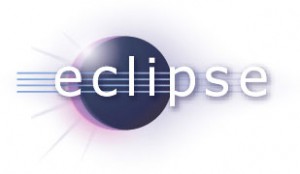 With the Spoofax/IMP language workbench, you can write the grammar of your language using the high-level SDF grammar formalism. Based on this grammar, basic editor services such as syntax highlighting and code folding are automatically provided. Using high-level descriptor languages, these services can be customized. More sophisticated services such as error marking and content completion can be specified using rewrite rules in the Stratego language.
With the Spoofax/IMP language workbench, you can write the grammar of your language using the high-level SDF grammar formalism. Based on this grammar, basic editor services such as syntax highlighting and code folding are automatically provided. Using high-level descriptor languages, these services can be customized. More sophisticated services such as error marking and content completion can be specified using rewrite rules in the Stratego language.
(more features)
 With the Spoofax/IMP language workbench, you can write the grammar of your language using the high-level SDF grammar formalism. Based on this grammar, basic editor services such as syntax highlighting and code folding are automatically provided. Using high-level descriptor languages, these services can be customized. More sophisticated services such as error marking and content completion can be specified using rewrite rules in the Stratego language.
With the Spoofax/IMP language workbench, you can write the grammar of your language using the high-level SDF grammar formalism. Based on this grammar, basic editor services such as syntax highlighting and code folding are automatically provided. Using high-level descriptor languages, these services can be customized. More sophisticated services such as error marking and content completion can be specified using rewrite rules in the Stratego language.
News
Spoofax 1.1 released
We are happy to announce the release of Spoofax 1.1! This is the first major release since version 1.0.2 and includes major features and improvements. Spoofax 1.1 supports all current Eclipse versions, up to version 4.2.2. You can update your Eclipse from http://download.spoofax.org/update/stable One of the most important improvements in Spoofax 1.1 is the inclusion of NaBL, the Spoofax Name Binding Language. NaBL is used in all new projects created and significantly simplifies name binding analysis, as well as any editor services that depend on it (e.g., code completion, reference resolving) NaBL is documented at the following pages:- Tutorial http://metaborg.org/wiki/nabl
- Examples http://metaborg.org/wiki/nabl/examples
- Research paper http://researchr.org/publication/KonatKWV13
- Improved build process: generated files can be deleted, building & loading are separated, projects can be cleaned (http://yellowgrass.org/issue/Spoofax/577, http://yellowgrass.org/issue/Spoofax/591, http://yellowgrass.org/issue/Spoofax/578)
- Improved Stratego editor with multi-file reference resolving based on NaBL (http://yellowgrass.org/issue/Spoofax/12)
- Extended support for customizing refactoring UI (http://yellowgrass.org/issue/Spoofax/440)
- Automatic configuration of git/svn ignore settings (http://yellowgrass.org/issue/Spoofax/573)
- Added support loading for Java-based plugin dependencies, in case your plugin depends on some other plugin such as EMF (http://yellowgrass.org/issue/Spoofax/322)
- Much improved completion engine (http://yellowgrass.org/issue/Spoofax/360)
- We now show a nice warning if Eclipse is not configured with a proper stack and heap size (http://yellowgrass.org/issue/Spoofax/86)
- Files are now queued for re-analysis even if their editor is not open (http://yellowgrass.org/issue/Spoofax/224)
Spoofax Q&A
We have started a Q&A site for Spoofax to build a knowledge base of common questions and answers. Join us at http://yellowgrass.org/questions/Spoofax 2012-02-15Spoofax 1.0.2 maintenance release
Today we're releasing a minor maintenance release of Spoofax, version 1.0.2. This release fixes a memory leak that was introduced in the 1.0 release. There are no new features in this release, those will be included in the upcoming 1.1 release instead. The new version is now available from the update site athttp://spoofax.org/update/stable.
2011-12-28
Spoofax 1.0
We're pleased to announce the release of Spoofax 1.0. A number of significant new features have been added since the last stable release, a long list of bugs has been fixed, and various minor improvements were introduced. Highlights of the release include:- Support for writing tests for language definitions
- Support for defining refactorings
- Major improvements to content completion: Spoofax/289, Spoofax/357
- Support for using rewrite rules to disambiguate syntax: Spoofax/328
http://spoofax.org/update/stable.
In addition to these features, we're actively working on improving Spoofax with new features. In particular, we are now working on providing full support for debugging, on an interactive shell for Stratego and custom languages, and a new meta-language called SpoofaxLang to define languages in a more modular fashion.
A full list of feature requests and issues addressed in the new version is provided at http://yellowgrass.org/tag/Spoofax/1.0.
Features
| Edit and use your language in one Eclipse window |

|
| Deploy your editor as a portable Eclipse plugin |

|
| Specify custom errors, warnings, and notes |

|
| Support content completion |

|
| Support reference resolving |

|
| Use concise rewrite rules for code generation |

|
| Generate code directly from any editor or selection |

|
| Apply refactoring transformations on the source code |

|
| Get a live abstract syntax view |

|
- ChangeLog
- CommandLine
- Components
- ContinuousBuildingSpoofax
- DebugStratego
- Development
- Devnology
- Documentation
- Download
- ExampleIni
- Examples
- FAQ
- Features
- IMP
- InteractiveDisambiguation
- LWC2011
- LayoutPreservation
- NBL
- NWL
- NaBL
- News
- Refactorings
- Research
- SemanticIndex
- SiteMap
- SpoofaxLanguage
- SpoofaxRelease11
- SummerSchool
- Support
- TemplateLanguage
- Testing
- TestingDemo
- Tour
- UpdateWebPages
- WebChanges
- WebChanges100
- WebChanges200
- WebChanges500
- WebCustomMenus
- WebHome
- WebIndex
- WebLeftBar
- WebNews
- WebNotify
- WebPreferences
- WebRss
- WebSearch
- WebSearchAdvanced
- WebStatistics
- WebTools
- WebTopicList
2002-01-23
- Creation of WebNews for _default web -- EelcoVisser
WebNotify is a subscription service to be automatically notified by email when topics change in the TWiki.Spoofax web. This is a convenient service, so you do not have to come back and check all the time if something has changed. To subscribe to the service, please put yourself on the list below. The format is:
3 spaces * Main.yourWikiName - yourEmailAddress
Note: It is helpful to insert your name in alphabetical order (by first name -- ignore the "Main.") -- then you can find your name (or not) more easily if you wish to remove it or confirm that you are on the list.
Related topics: TWikiUsers, TWikiRegistrationTWiki.Spoofax Web Preferences
The following settings are web preferences of the TWiki.Spoofax web. These preferences overwrite the site-level preferences in TWikiPreferences, and can be overwritten by user preferences (your personal topic, i.e. TWikiGuest in the TWiki.Main web) Preferences:- Web specific background color: (Pick a lighter one of the StandardColors; default FFD8AA)
- Set WEBBGCOLOR = #FFFFFF
- Set WEBHEADERBGCOLOR = #FFFFFF
- Exclude web from a
web="all"search: (Set toonfor hidden webs)- Set NOSEARCHALL =
- Default template for new topics and form(s) for this web:
- WebTopicEditTemplate?: Default template for new topics in this web. (Site-level is used if topic does not exist)
- TWiki.WebTopicEditTemplate: Site-level default template
- TWikiForms: How to enable form(s)
- Set WEBFORMS =
- Users or groups who are not / are allowed to view / change / rename topics in the Spoofax web: (See TWikiAccessControl)
- Set DENYWEBVIEW =
- Set ALLOWWEBVIEW =
- Set DENYWEBCHANGE =
- Set ALLOWWEBCHANGE = StrategoGroup
- Set DENYWEBRENAME =
- Set ALLOWWEBRENAME = StrategoGroup
- Users or groups allowed to change or rename this WebPreferences topic: (I.e. TWikiAdminGroup)
- Set ALLOWTOPICCHANGE = StrategoGroup
- Set ALLOWTOPICRENAME = StrategoGroup
- Web preferences that are not allowed to be overridden by user preferences:
- Set FINALPREFERENCES = WEBTOPICLIST, DENYWEBVIEW, ALLOWWEBVIEW, DENYWEBCHANGE, ALLOWWEBCHANGE, DENYWEBRENAME, ALLOWWEBRENAME
- Stuff documented at TWikiPreferences:
- Set SKIN = flexpattern
- Set TWIKILAYOUTURL = /pub/TWiki/PatternSkin/layout.css
- Set TWIKISTYLEURL = http://strategoxt.org/pub/Spoofax/WebPreferences/style.css
- A preference is defined as:
6 spaces * Set NAME = value
Example:- Set WEBBGCOLOR = #FFFFC0
- Preferences are used as TWikiVariables by enclosing the name in percent signs. Example:
- When you write variable
%WEBBGCOLOR%, it gets expanded to#FFFFFF.
- When you write variable
- The sequential order of the preference settings is significant. Define preferences that use other preferences first, i.e. set
WEBCOPYRIGHTbeforeWIKIWEBMASTERsince%WEBCOPYRIGHT%uses the%WIKIWEBMASTER%variable. - You can introduce new preferences variables and use them in your topics and templates. There is no need to change the TWiki engine (Perl scripts).
- TWikiPreferences has site-level preferences.
- TWikiUsers has a list of user topics. User topics can have optional user preferences.
- TWikiVariables has a list of common
%VARIABLES%. - TWikiAccessControl explains how to restrict access by users or groups.
Number of topics: 0
- Topic index: List of Spoofax topics in alphabetical order.
|All|A|B|C|D|E|F|G|H|I|J|K|L|M|N|O|P|Q|R|S|T|U|V|W|X|Y|Z|
| All topics in BookView |
- Jump to topic: If you already know the name of the topic, enter the name of the topic into the GoBox at the top
- WebChanges: Find out what topics in Spoofax have changed recently
- How to edit text:
- Make changes to topics in GoodStyle,
- Learn the TextFormattingRules, and
- Have a look at the TextFormattingFAQ
- Topic index: List of Spoofax topics in alphabetical order.
|All|A|B|C|D|E|F|G|H|I|J|K|L|M|N|O|P|Q|R|S|T|U|V|W|X|Y|Z|
| All topics in BookView |
- Jump to topic: If you already know the name of the topic, enter the name of the topic into the GoBox at the top
- WebChanges: Find out what topics in Spoofax have changed recently
- How to edit text:
- Make changes to topics in GoodStyle,
- Learn the TextFormattingRules, and
- Have a look at the TextFormattingFAQ
Statistics for TWiki.Spoofax Web
| Month: | Topic views: | Topic saves: | File uploads: | Most popular topic views: | Top contributors for topic save and uploads: |
|---|---|---|---|---|---|
- Do not edit this topic, it is updated automatically. (You can also force an update)
- TWikiDocumentation tells you how to enable the automatic updates of the statistics.
- Suggestion: You could archive this topic once a year and delete the previous year's statistics from the table.
Finding topics
Tracking activity
- WebNews: selected changes
- WebChanges: recent changes
- WebNotify: email notification of changes
- WebStatistics: usage counts
- WebPreferences: values of variables
- WebContents?: web specific entries in the side bar
- ChangeLog
- CommandLine
- Components
- ContinuousBuildingSpoofax
- DebugStratego
- Development
- Devnology
- Documentation
- Download
- ExampleIni
- Examples
- FAQ
- Features
- IMP
- InteractiveDisambiguation
- LWC2011
- LayoutPreservation
- NBL
- NWL
- NaBL
- News
- Refactorings
- Research
- SemanticIndex
- SiteMap
- SpoofaxLanguage
- SpoofaxRelease11
- SummerSchool
- Support
- TemplateLanguage
- Testing
- TestingDemo
- Tour
- UpdateWebPages
- WebChanges
- WebChanges100
- WebChanges200
- WebChanges500
- WebCustomMenus
- WebHome
- WebIndex
- WebLeftBar
- WebNews
- WebNotify
- WebPreferences
- WebRss
- WebSearch
- WebSearchAdvanced
- WebStatistics
- WebTools
- WebTopicList
Number of topics: 51